Author Archives: Josh
Iceland Gull (Thayer’s)
Bohemian Waxwing
White-winged Scoter
Iron Range Birding Scraps
In any project there is inevitably scrap material left over. Some pieces of lumber, fabric, etc. are just too good to discard, or more likely, the memories of long-gone, thrifty grandparents guilt us in to keeping these items. So we pile our garages and closets full of such things until they can be re-purposed, which never, ever happens. Except for today. The trip up north yielded two solid projects with the Great Gray Owl adventure and the Golden-crowned Sparrow chase, but there were plenty of good birding scraps that I couldn’t waste. In fact, they might even be worthy of being displayed on my 4th-grade science fair tri-fold that was stowed away in Grandma’s garage for decades.
Not every bird scrap here will have a photo. That’s just how it goes sometimes. Good bird sightings are good bird sightings period. So let’s kick off this post with the birds that were not photographed.
Black-billed Magpie
Black-billed Magpie is a great northern Minnesota bird, and the Sax-Zim Bog is the furthest-east that it is known to breed. Lately they have been popping up all over the Iron Range in the open agricultural areas. I found four a couple months ago just a few miles from my parents’ house. This trip I saw one fly across my in-laws’ gravel road. This was my best non-Great Gray Owl/non-Golden-crowned Sparrow sighting of the trip. I have traveled that road for almost 20 years and have never seen one there before.
Rough-legged Hawk
This is flat-out one of the best hawks. Many migrate through Minnesota during late fall, and since we’ve been birders I have seen them every time we visit up north this time of year. I am now starting to associate Thanksgiving with this bird instead of the turkey. Anyhow, just moments before that Black-billed Magpie, I got my best-ever look at a gorgeous light-morph perched on a power pole by the road. We were on our way to a family gathering so I didn’t have time to stop and photograph it. I did drive real slow when I went by, and that hawk and I locked eyes while it pivoted its head watching me when I went past, just like an owl would do. Super-cool.
Pine Grosbeaks
This bird was seemingly everywhere on the trip. I bet I saw over two dozen in various places. My sightings occurred exclusively as birds getting grit from the middle of roads. Anytime I stopped to get a photograph, they would split. Though I have seen gobs of these things on feeders long before I was a birder, this bird has eluded my camera since I got into birding. There was that one crummy cell-phone pic a couple years ago. I guess this one is a step-up. FYI – rolling down the windows of a toasty vehicle and then immediately taking pictures in the cold does not work; the heat waves from the car create interference in the picture. Instead, keep the windows down a bit as you roll along or turn down the heat.
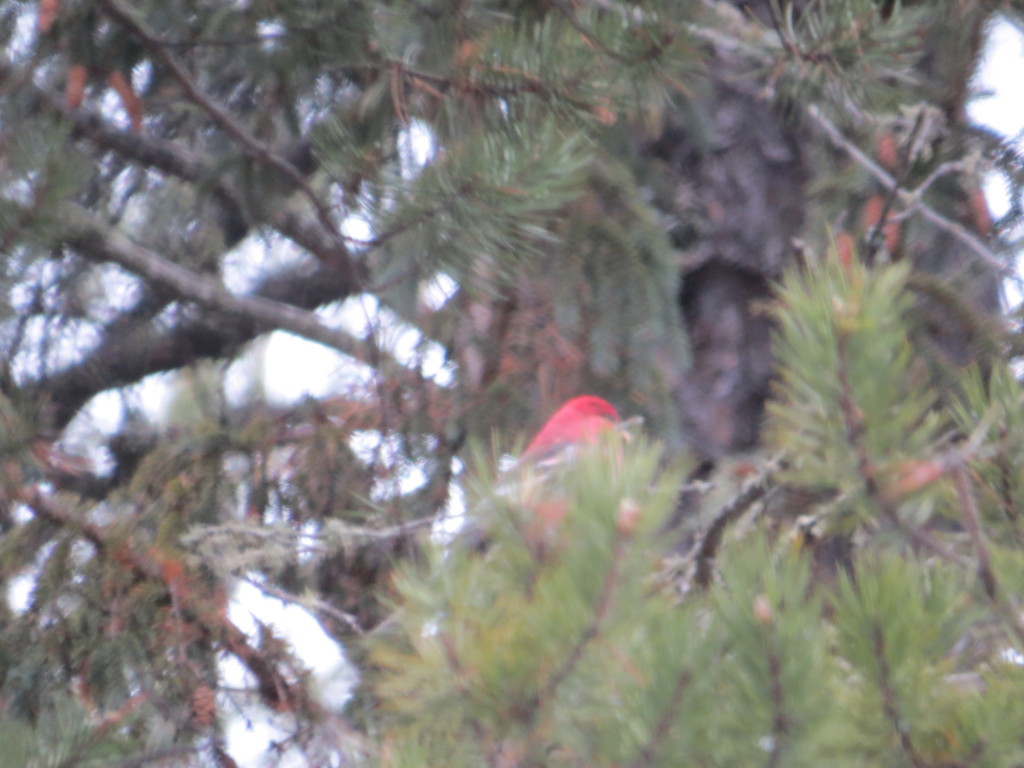
Northern Shrikes
What birder doesn’t love a shrike of any stripe? Fall is the time when the Northerns replace the Loggerheads. Unlike the rare Loggerhead, the Northern Shrike is not terribly uncommon anywhere in the state during the winter. I found two when I drove through the Sax-Zim Bog on my way home from Duluth.
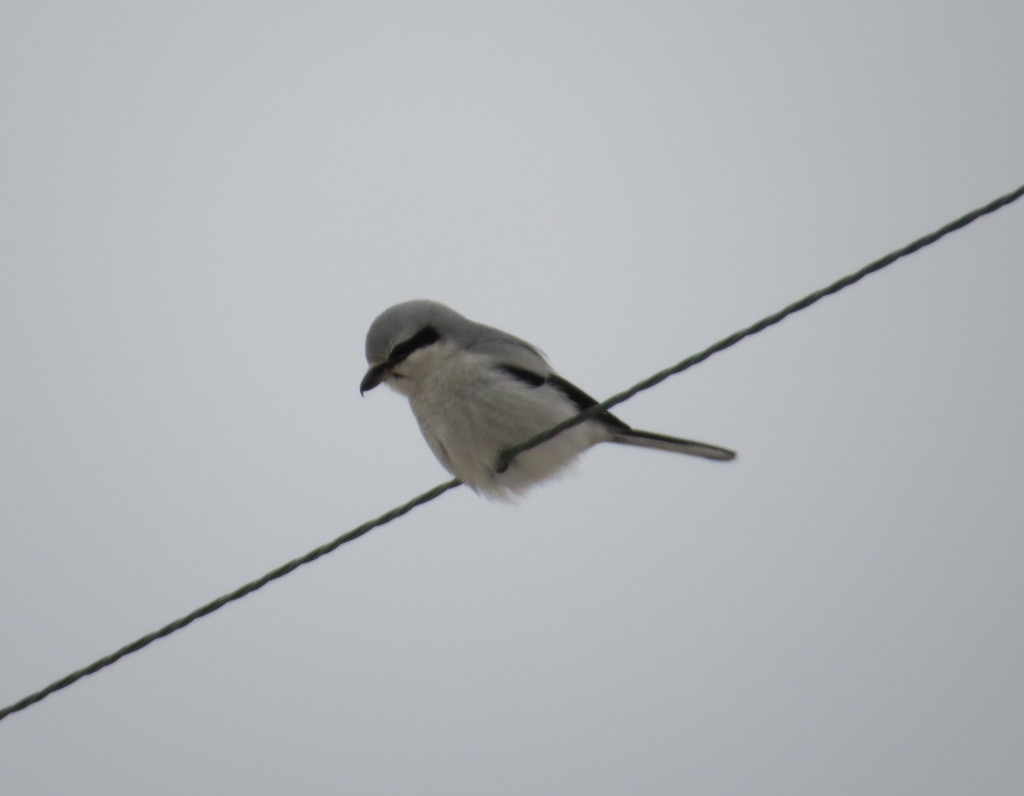
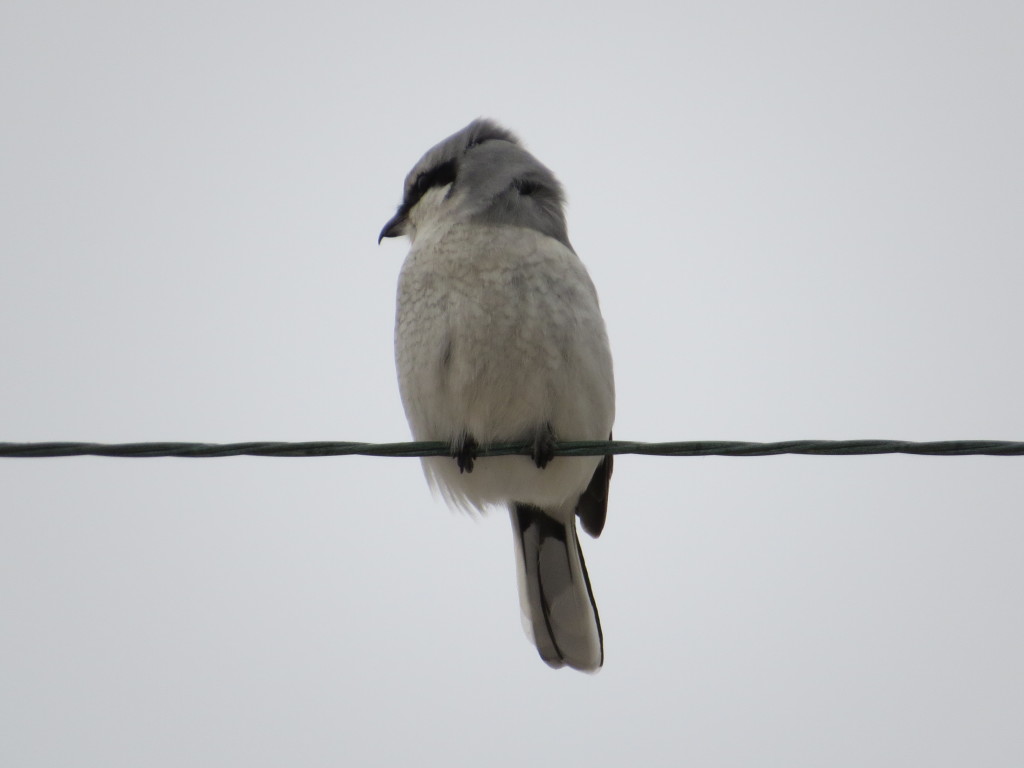
Ruffed Grouse – aka “grouse” to Minnesotans at large, aka “partridge” to Iron Rangers
We went to Melissa’s Grandma’s house on Turkey Day. This is always a fascinating place to do some birding while eating Grandma Evelyn’s delicious food and sipping some coffee. Pine Grosbeaks, Evening Grosbeaks, a Great Gray Owl next door. You know, the usual stuff. Knowing this, I walked up to the house with my camera in hand, eager to see what goodies were on Evelyn’s feeders. A large bird at the top of a birch tree immediately caught my attention.
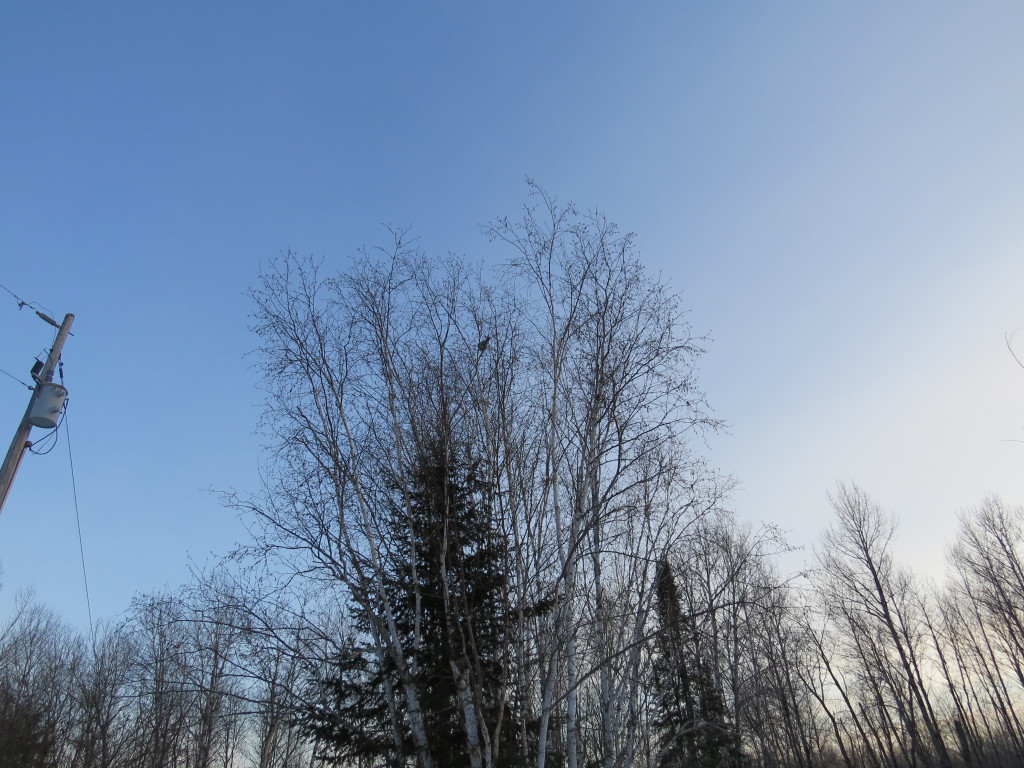
It was a grouse! Grouse in northern Minnesota are practically as common as chickens in a barnyard, but it was fun to see one so tame and without a care in the world other than stuffing his crop with all the birch catkins he could eat. Apparently he knew he wasn’t the bird of choice on this day and was safe from those who craved poultry. In fact, I walked all around the tree right underneath him while he busily ate the catkins.
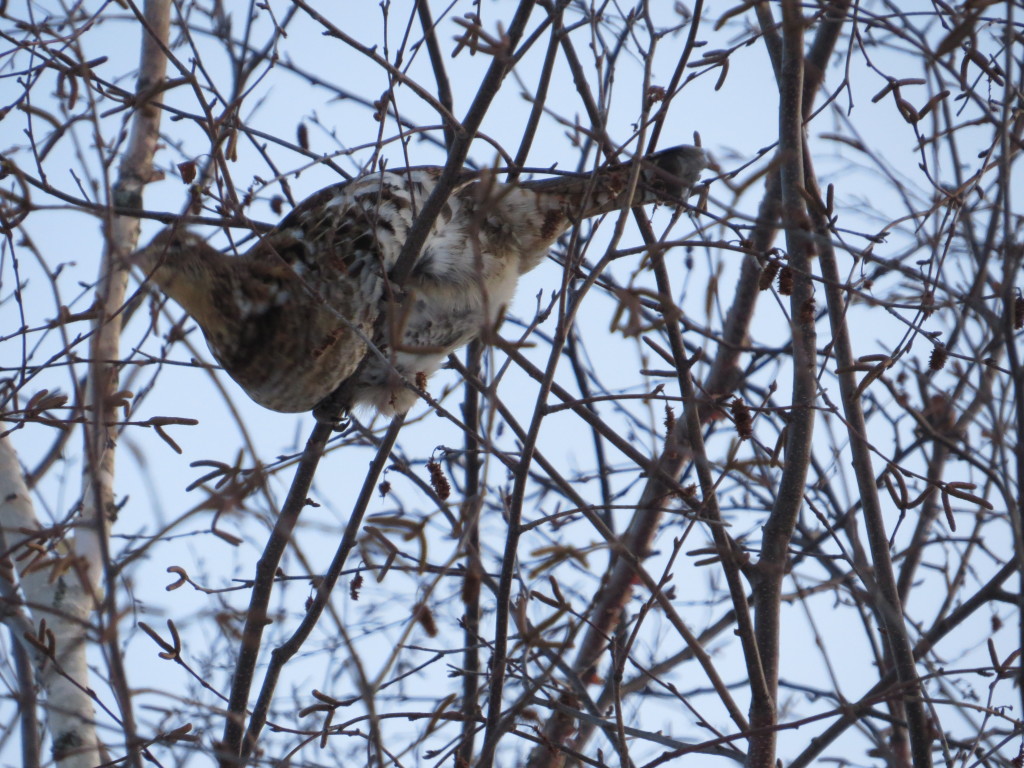
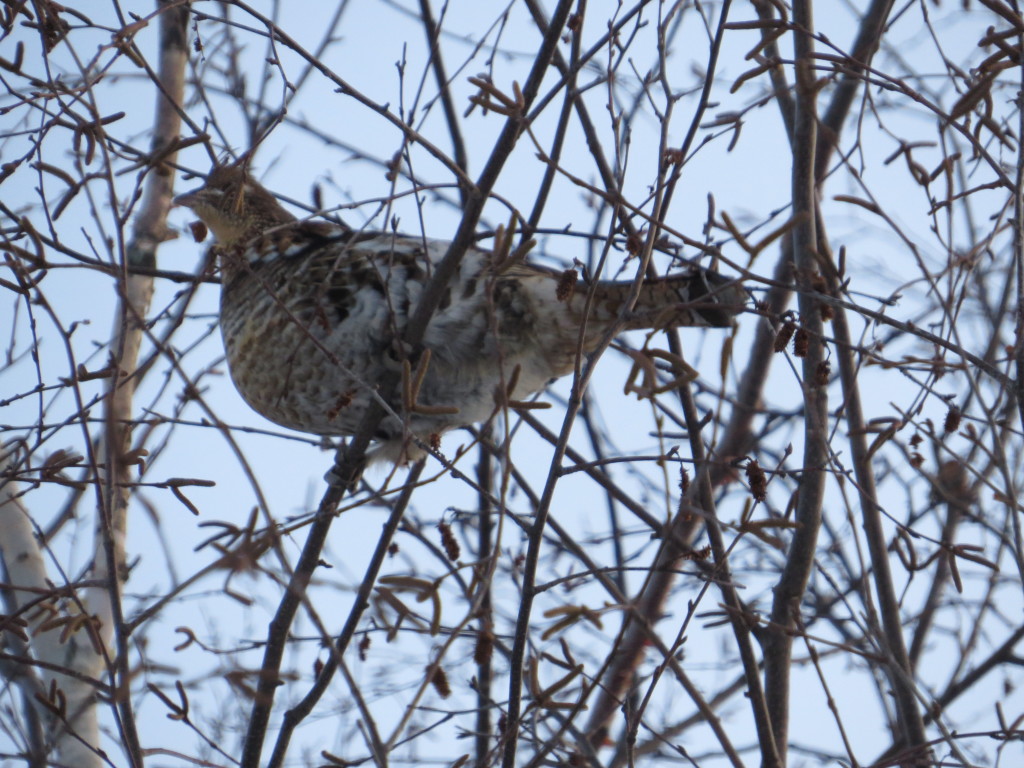
This was a real treat to be able to photograph this bird so close. The Ruffed Grouse has been a favorite bird of mine ever since I was a 13-year-old kid and had one flush across a wooded path right in front of me, and then it strutted on a log. One thing I particularly enjoyed about this grouse at Evelyn’s house was its long, red-phase tail. The long tail indicates that this is a male. Ruffed Grouse tails come in a gray phase or a red phase with a lot of variation in between. Most of the birds I see are gray phase. Here is a sample of this variation from Gordon Gullion’s The Ruffed Grouse. Gullion states that there are up to 30 color variations in the tails and provides loads of statistics on the rarity of the different types. The best tail feather I ever found as a kid was a gray-phase tail with an orange sub-terminal band instead of the traditional black.
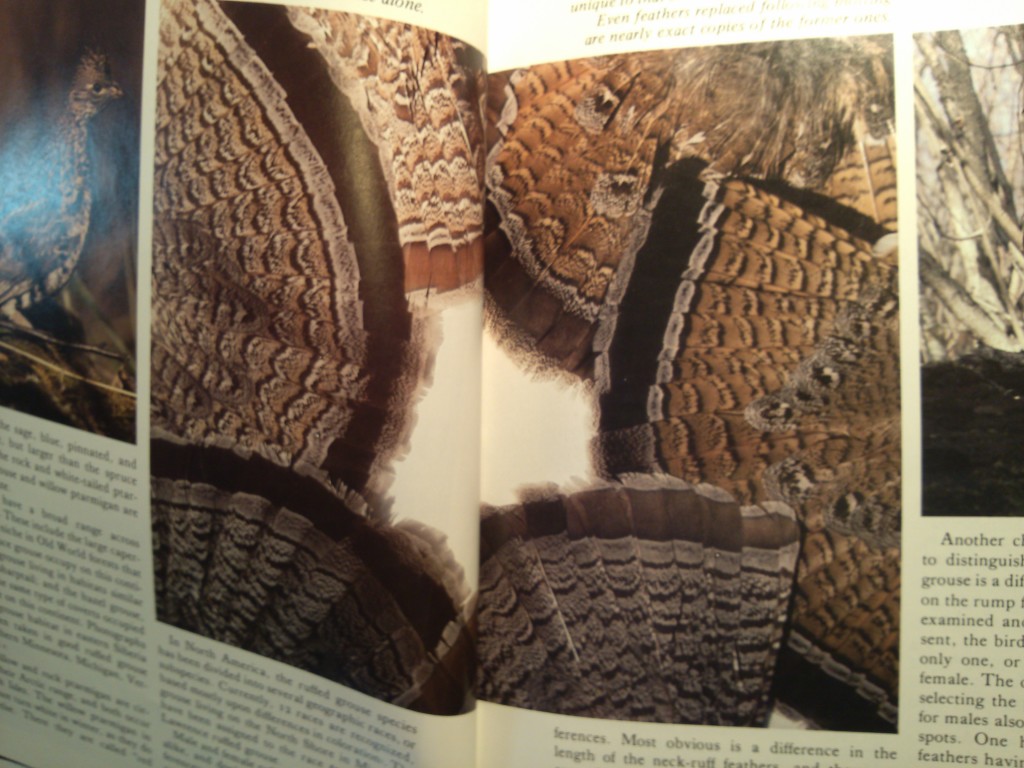 Fun fact from Gullion’s book: It is well-known that Ruffed Grouse completely burrow into powdery snow to keep warm on cold winter days. However, what is not well known is that the Great Gray Owl is the only known predator that can hear the grouse in their burrows and pluck them out of the snow! How cool is that?! Here I thought Great Grays just ate small rodents. As Gullion says, it’s fortunate for Ruffed Grouse that Great Gray Owls are not very numerous in northern Minnesota. If I ever witnessed such predation, I might have to hang up my binoculars and camera because it just wouldn’t get any better than that. Fortunately, Evelyn’s grouse doesn’t have to worry about such things yet with low snow totals. But he sure looks plump for the pickin’.
Fun fact from Gullion’s book: It is well-known that Ruffed Grouse completely burrow into powdery snow to keep warm on cold winter days. However, what is not well known is that the Great Gray Owl is the only known predator that can hear the grouse in their burrows and pluck them out of the snow! How cool is that?! Here I thought Great Grays just ate small rodents. As Gullion says, it’s fortunate for Ruffed Grouse that Great Gray Owls are not very numerous in northern Minnesota. If I ever witnessed such predation, I might have to hang up my binoculars and camera because it just wouldn’t get any better than that. Fortunately, Evelyn’s grouse doesn’t have to worry about such things yet with low snow totals. But he sure looks plump for the pickin’.
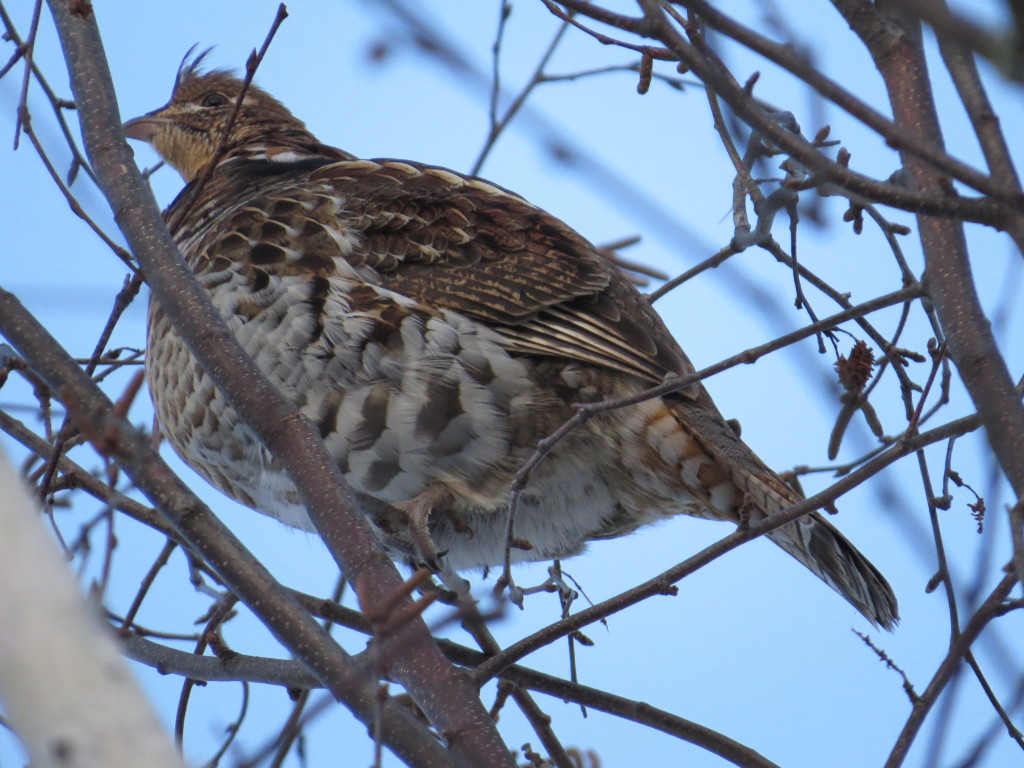
A Golden Opportunity for Sparrowing
Being in northern Minnesota puts one in striking distance of multiple great birding opportunities. And in the case of this birder, it also puts him in close proximity of many relatives. Therefore the decisions must be weighed carefully; there is no room for making a foolish birding decision with a limited amount of time to bird. The Sax-Zim Bog venture was savvy and efficient as it was en route to our destination. With some successful owling in the Bog, I didn’t feel the need to go back. Instead, there were two other options that were now vying heavily for my attention: go to the Isabella area in Lake County after reports of gobs of Spruce Grouse, Black-backed Woodpeckers, Northern Hawk Owls, and Boreal Chickadees or go back to Duluth to try to see Minnesota’s 10th only Golden-crowned Sparrow. Time and distance would not allow me to do both. The boreal birds were really appealing to me, but I instead made the more logical, albeit less fascinating, decision to go after the sparrow. The boreal birds will always be boreal, but the Golden-crowned Sparrow will not. Also, being up north only put me 1.5 hours away from Duluth instead of the normal 3.5 hours away. It was the right thing to do.
One of my benchmarks for deciding to chase a rarity is whether or not Randy chases. If he’s never seen it, then it’s an incredible bird. 2014 has been unbelievable as Randy has added seven state birds when he normally gets one maybe every couple years. The Golden-crowned Sparrow was one such bird. Being on opposite ends of the state did not allow us to chase together, but that didn’t stop us from joining forces at dawn last Saturday in Duluth. I was glad to not be going about this alone as this Sparrow had been showing up sporadically at Jeff Newman’s feeders on Regent Street. Some birders had been traipsing all over alleys and surrounding blocks in their efforts to locate the Golden-crowned. That seemed like a daunting proposition.
So the plan was to be at the house at first light to hopefully see the Sparrow grab its first meal for the day. As we stood on the sidewalk (birders were not to go on the lawn) in the pre-dawn of a cloudy day looking to the feeders in the backyard, we could barely make out the silhouette of the first bird to land on the ground. Just as it did, the homeowner, Jeff, came out his door to announce the identification he made from his much closer view from inside the house.
“White-throated Sparrow!” Back inside he went.
That silhouette flew and was replaced by another.
“Golden-crowned Sparrow!” Jeff proclaimed as he came out his front door for the second time in as many minutes. With the shared lifer now under our belts, Randy and I were no longer waiting on the bird but on the sun for some better looks at what we traveled so far to see. Here is one of those sketchy first looks in the dim morning light.
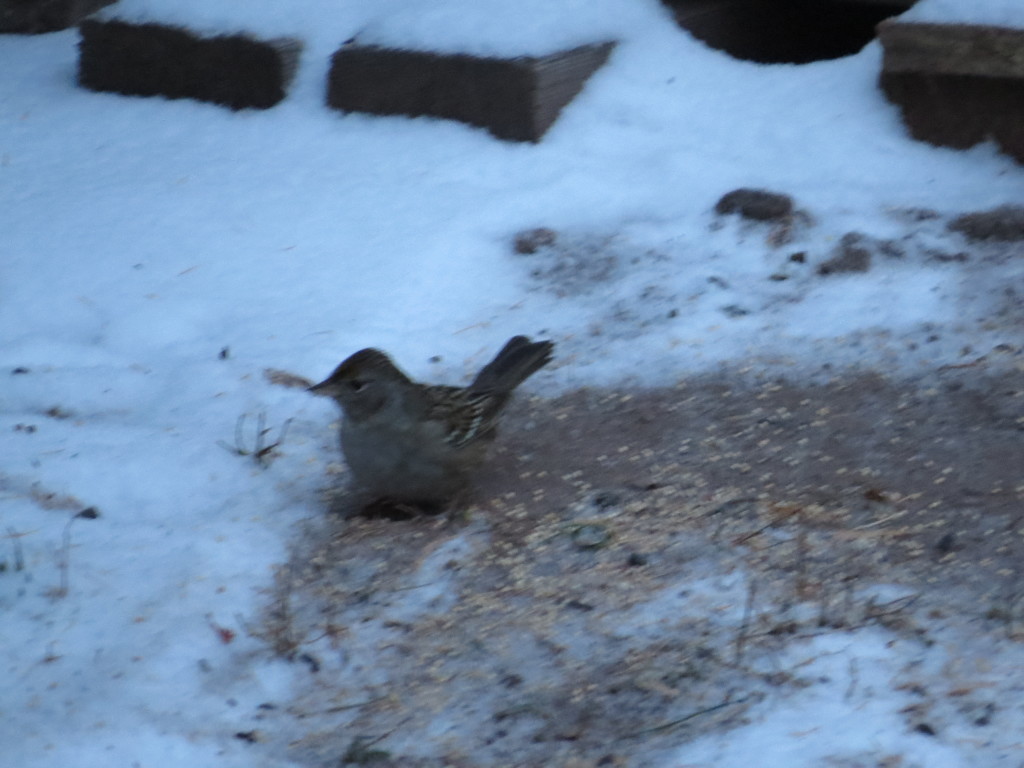
Just as other birders had said, the Sparrow did not spend much time feeding. Instead, it hung out in two cedar trees near the feeders. Now the sun and the branches were conspiring against us.
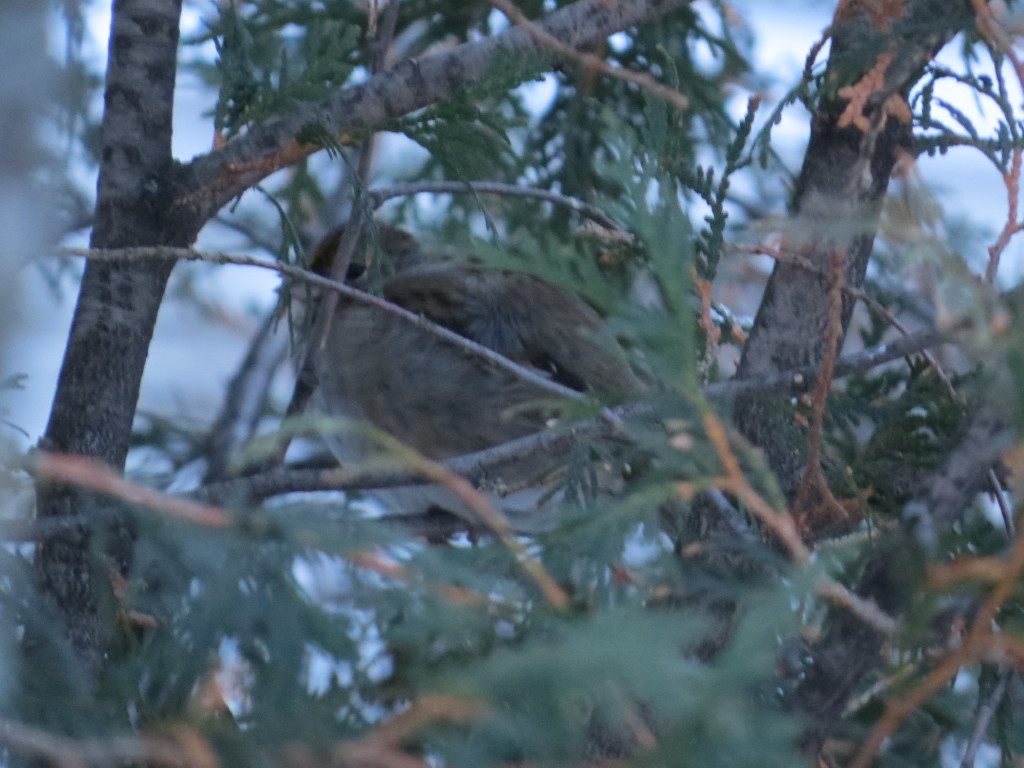
But eventually things started looking up as the morning progressed and the bird came out into the open for brief spurts.
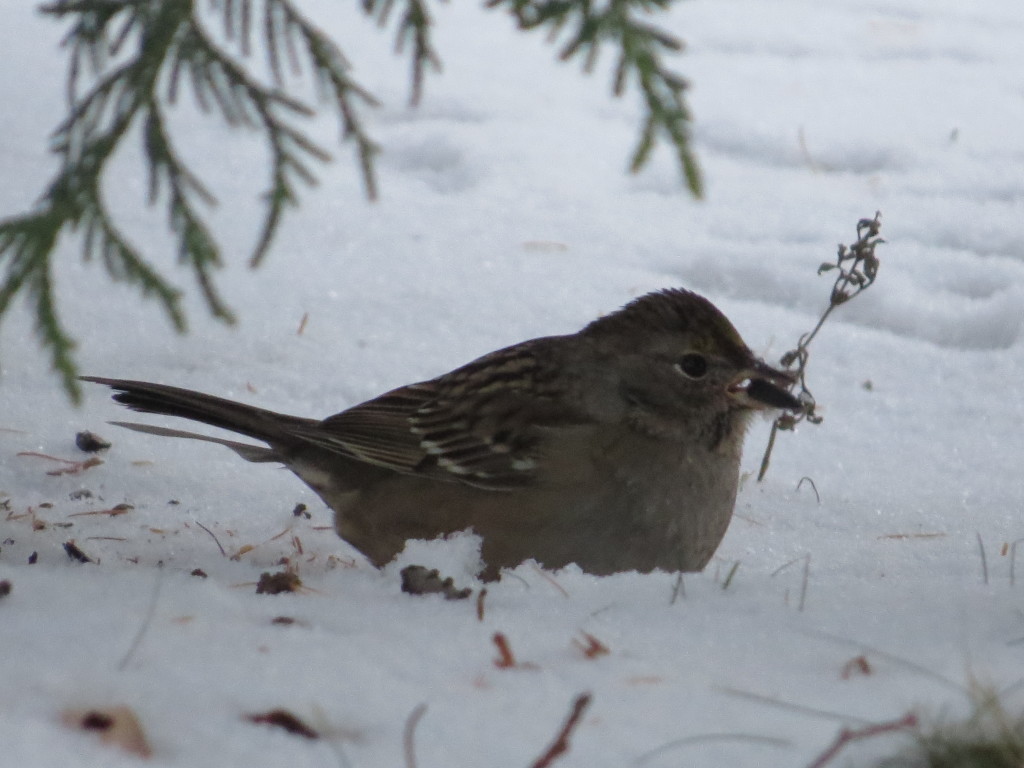
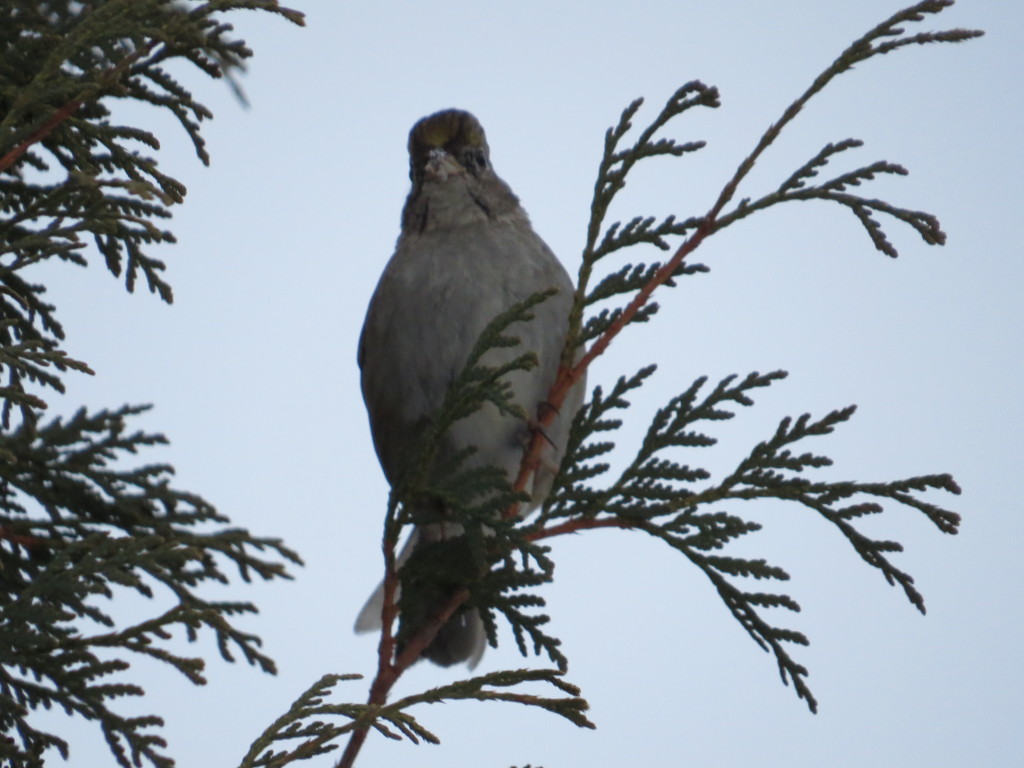
Then, finally, after an hour there was decent light and a perfectly-perched bird.
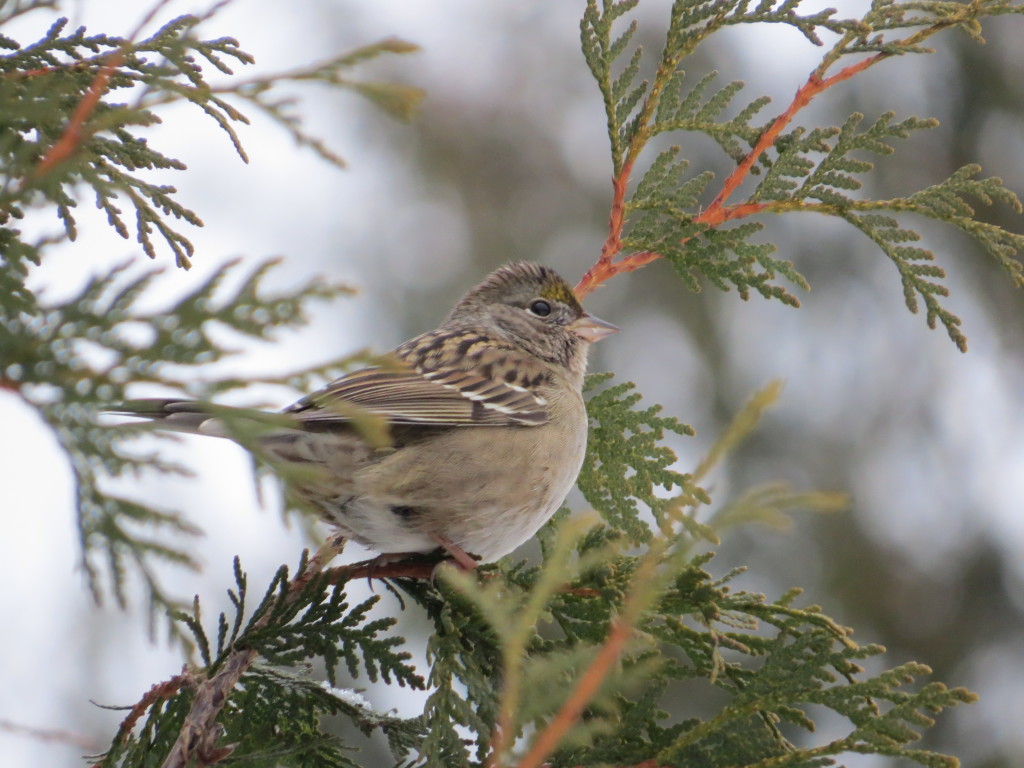
With a lifer and an okay photo, it was time to move on with the day. Randy and I split. He went for that Common Eider while I contemplated my next move. It was now 8:00, and I didn’t have to be anywhere until 2:00. I was tempted to go to Isabella, but the distance and my lack of experience in that area caused me to decide against it. Instead I opted to hang out in the Sax-Zim Bog for a few hours which was on my way home. My next post will detail some of the random good birds I found in the Bog and in other parts of the Iron Range.
Great Gray Owls – Served up Family Style in the Sax-Zim Bog
‘Tis the season when we load up the vehicle with kids and dogs and gear to make the long trek up north for Thanksgiving. Or, this year it was load up the van, have the van die in the garage because of a failed alternator, unload the said van, and re-load the contents into the much smaller SUV and hit the road with minimal disruption to the planned schedule. Such an ordeal is stressful enough, but to the birder who knows the Sax-Zim Bog is en route and who knows that many owls have been seen there recently, it was especially stressful. I was hoping to pass through the Bog before we got to Mom and Dad’s who live just 40 minutes north of the Bog, but the vehicle dilemma was putting all of this in doubt. It turns out that I was able to get us reconfigured or crammed, rather, into the new mode of transportation, and we were only delayed by an hour.
I hadn’t mentioned to Melissa that I wanted to pass through the Bog which seriously only adds about 5 miles to our trip. Notice I did not mention how much time it can add. 🙂 Anyhow, as we were driving into the north country Melissa read my mind and said, “I suppose you want to bomb through the Bog on the way home.” Isn’t she great? I didn’t even have to ask.
So that’s what we did. Heading down Arkola Road from Cotton we had some nice birds to see right away on the road as we flushed a small flock of Pine Grosbeaks and some Common Redpolls. But we were not here for the piddly stuff and were instead here for the big game of birding, Great Gray Owls. Birders had been seeing them out on the roads much more regularly now with the winter weather upon us. From what I’ve gathered, I suspect that a family of resident Great Grays had been frequenting a couple roads quite regularly.
Regular or not, I wasn’t taking chances as I had my secret weapon along — Melissa is our chief owl spotter. She found all five Great Grays in Aitkin last December, and she found most of our Burrowing Owls in Arizona last March. She’s good, and I was happy to have her along to help. Plus I think she likes the thrill of the hunt.
As we cruised along the spruce-lined, gravel road at 5 MPH straining to pick out one of these well-camouflaged birds, an enormous bird flushed from the spruce trees on my left and flew a short distance before disappearing into the dark swamp forever. The view was brief but undeniable – Great Gray Owl! It was a thrill, but a cheap one. We were also after good looks at these amazing creatures. I stopped the vehicle where he went into the woods and looked, but it was useless as you couldn’t see into the thick spruce bog.
Oh well. We kept on cruising. Then all of the sudden I saw another Great Gray Owl flying low above the ditch on the right side going straight away from us! Then it crossed the road and set up in the trees on the left side of the road, but we didn’t see exactly where it perched. This stand of trees was thinner, and I knew we would eventually spot it. “There it is!” shouted COS.
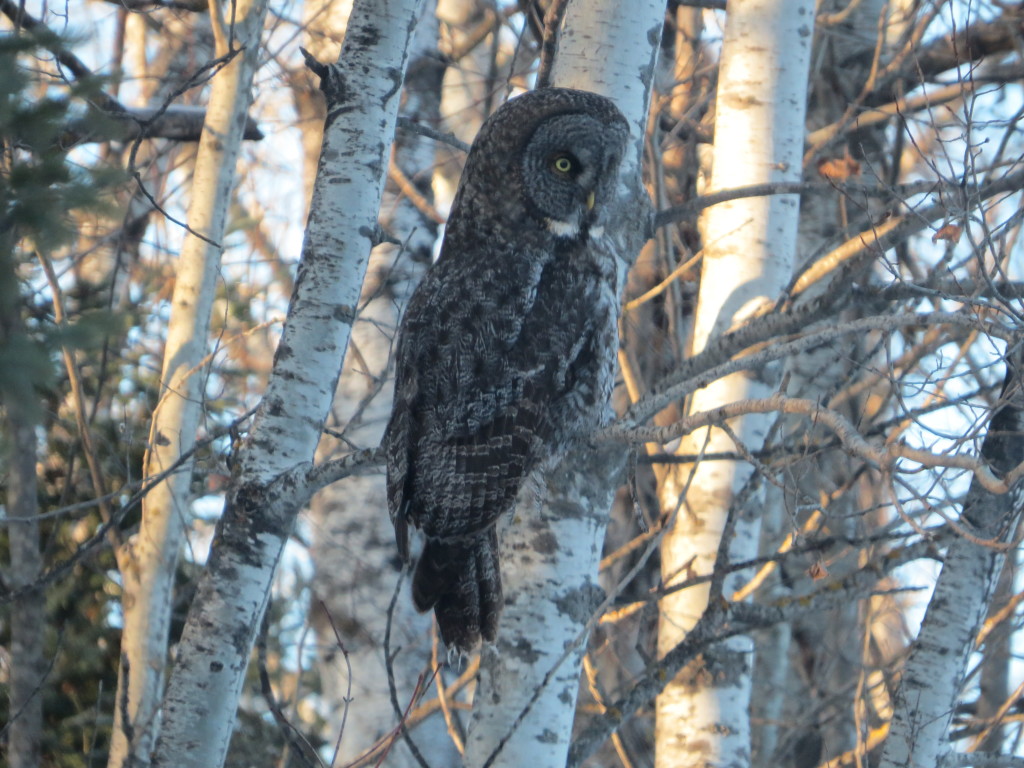
Everybody, including the two dogs, were excited. As we were making exclamations in the car, Chance couldn’t handle it and tried to come up and over the rear seat which caused Marin to scream. I immediately threw the car in reverse and got far away from the owl so I could solve this unexpected by-product of an owl-spotting without spooking the owl that caused the spotting. Once everybody and every dog was calm and its place, the owl-enjoyment began again.
My experience with Great Grays is that they really don’t care about you. They’re going to do what they need to do whether they are being watched or not. This owl was constantly moving around and looking for places from which to hunt meadow voles.
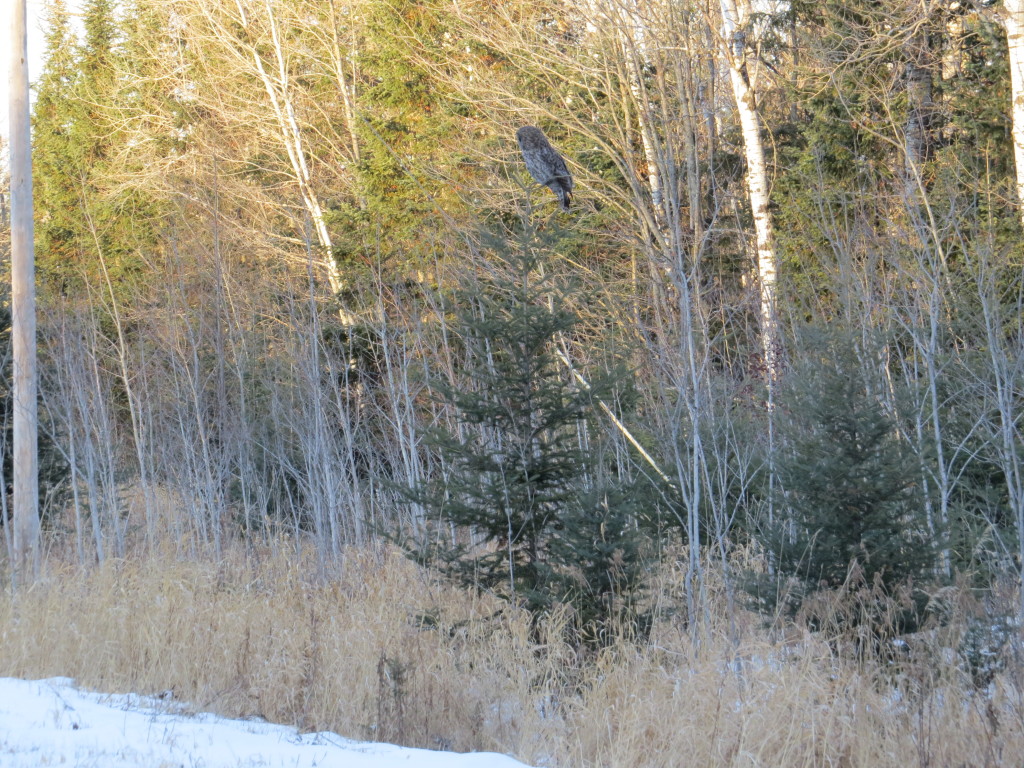
Great Grays have incredible hearing and can hear the voles running under the snow. We saw this one go down a couple of times. It wasn’t successful. Given that this owl did appear on the small side and that it wasn’t a skilled hunter, I’m guessing it was a young bird.
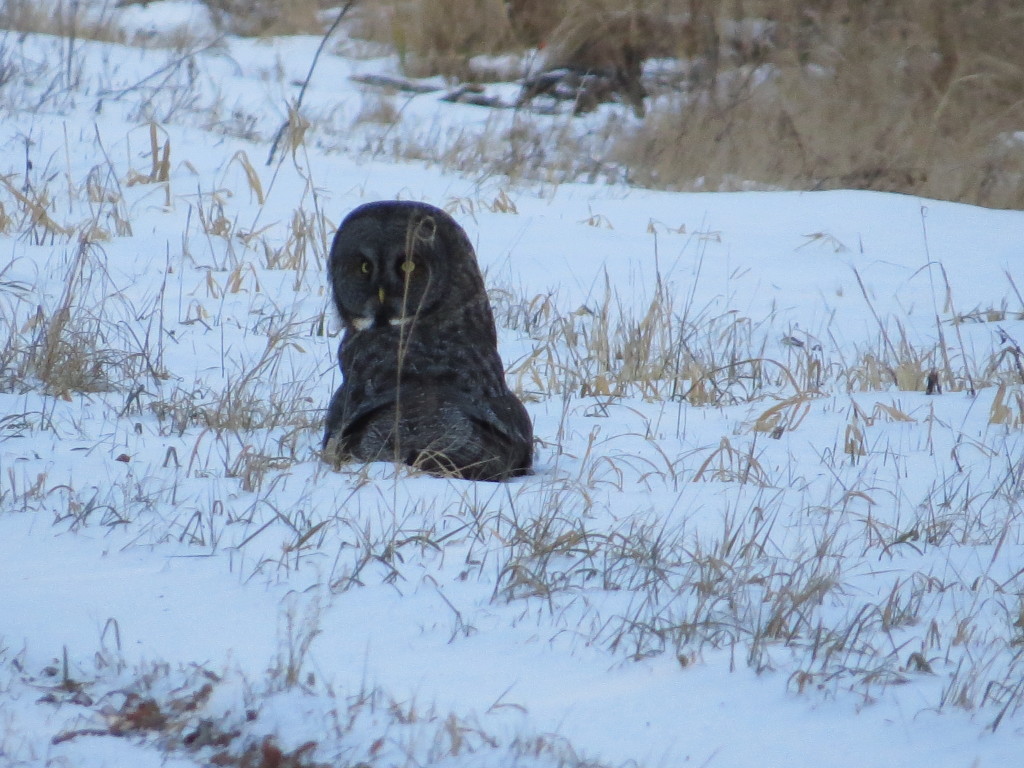
He never stopped trying, though. Every time it flew, we remarked how spookily and silently they move. At one point it flew right toward us and just to the side of the car before finding this new perch.
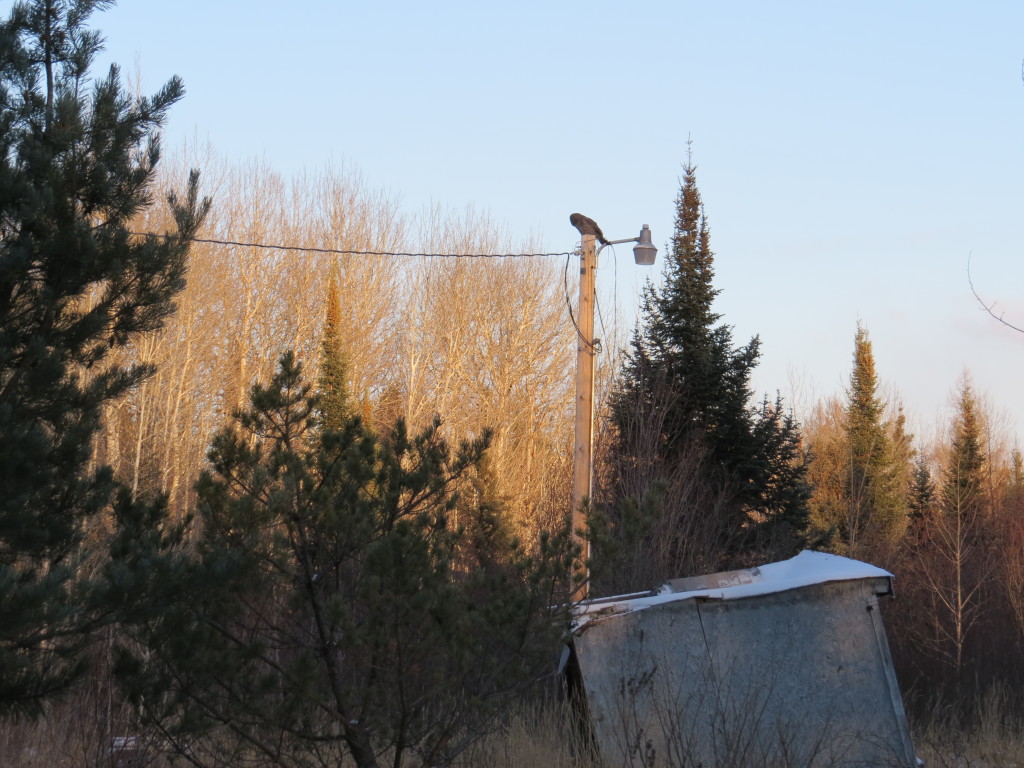
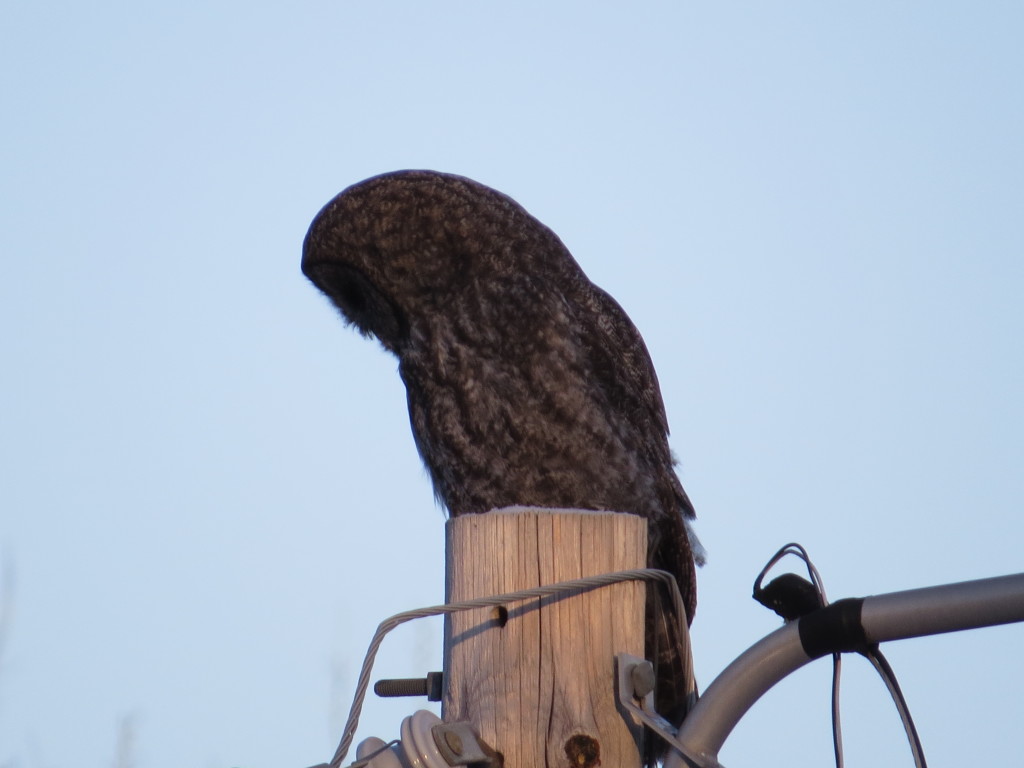
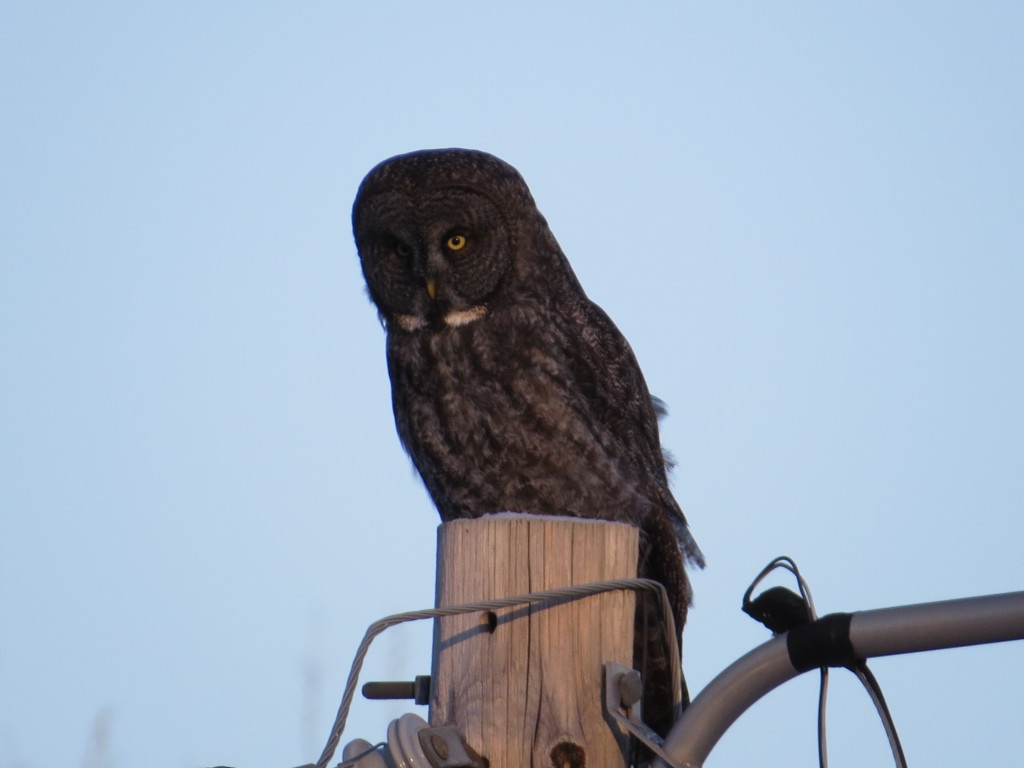
I never get tired of seeing Great Gray Owls. They are incredibly cool and mysterious. Even Melissa was enthralled with this bird. We continued to enjoy it until it eventually went out of sight.
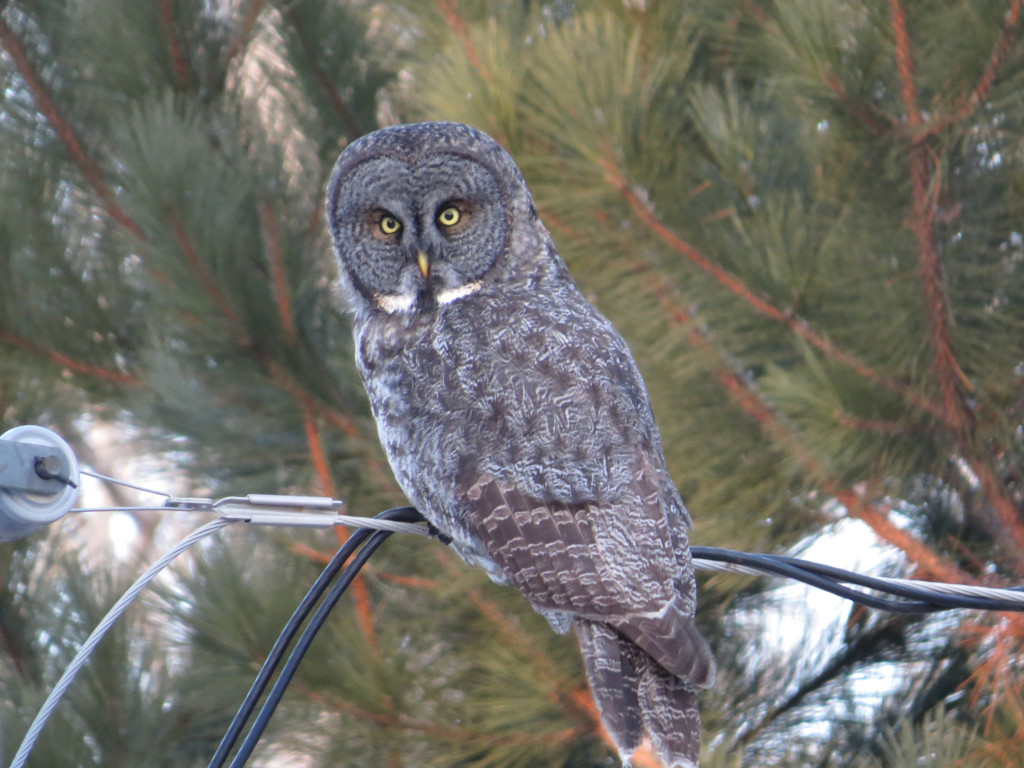
Two Great Grays, I couldn’t believe it. That’s the best I’ve done in the Bog. Nevertheless, they are addicting and we couldn’t stop, especially since some birders had seen 4 or 5 the day before. We had just enough time to check one more road. We drove down the road fast so that we could turn around and have the quickly setting sun at our backs. This time we drove slow. COS was straining to look ahead. I think she was hooked on the thrill of the hunt. And then COS did it again as she pointed straight-ahead and said, “Josh!” Do you see what COS saw?
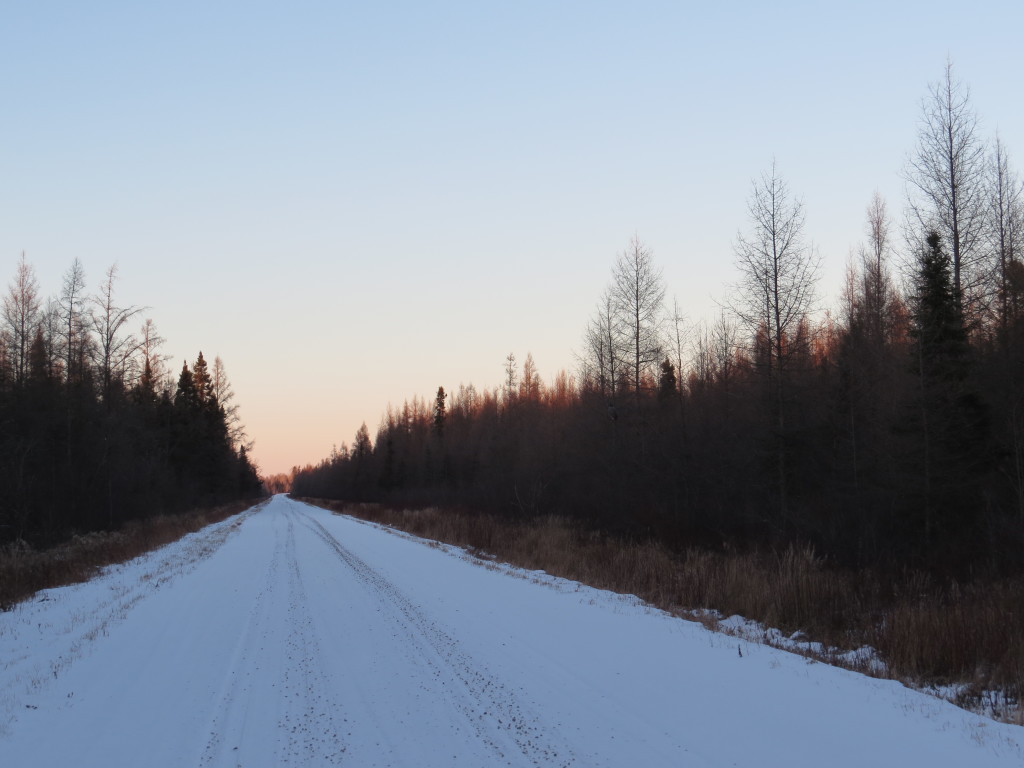
These things blend in like you wouldn’t believe, something that COS said was amazing considering how big they are. And this one was big, really big.
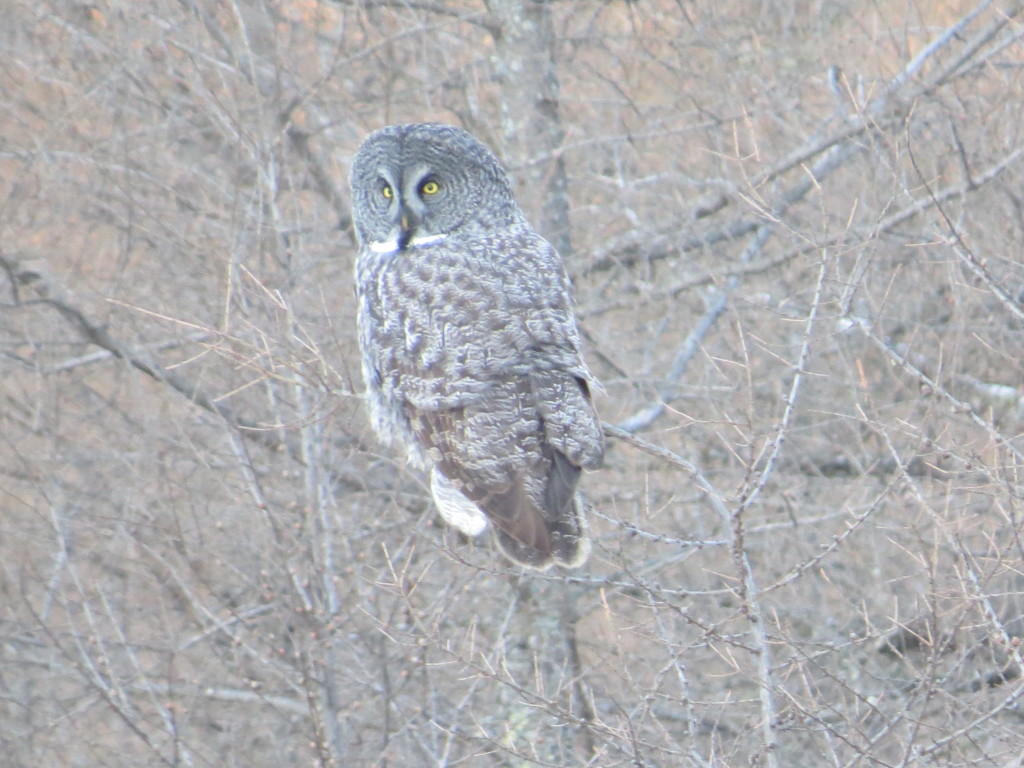
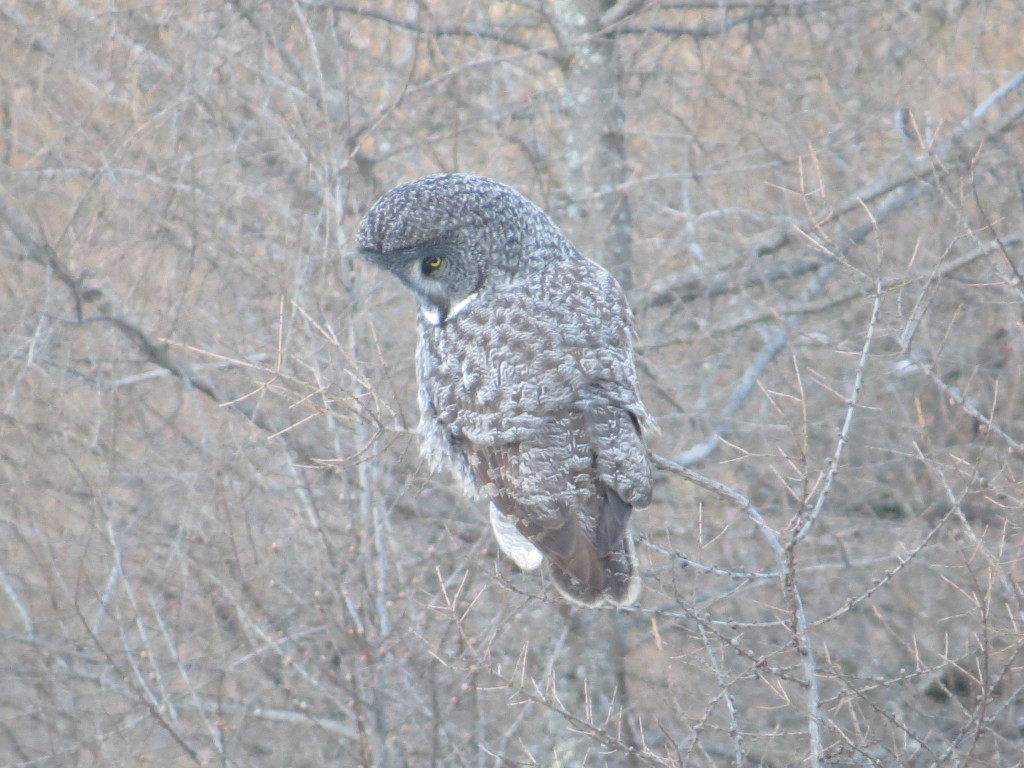
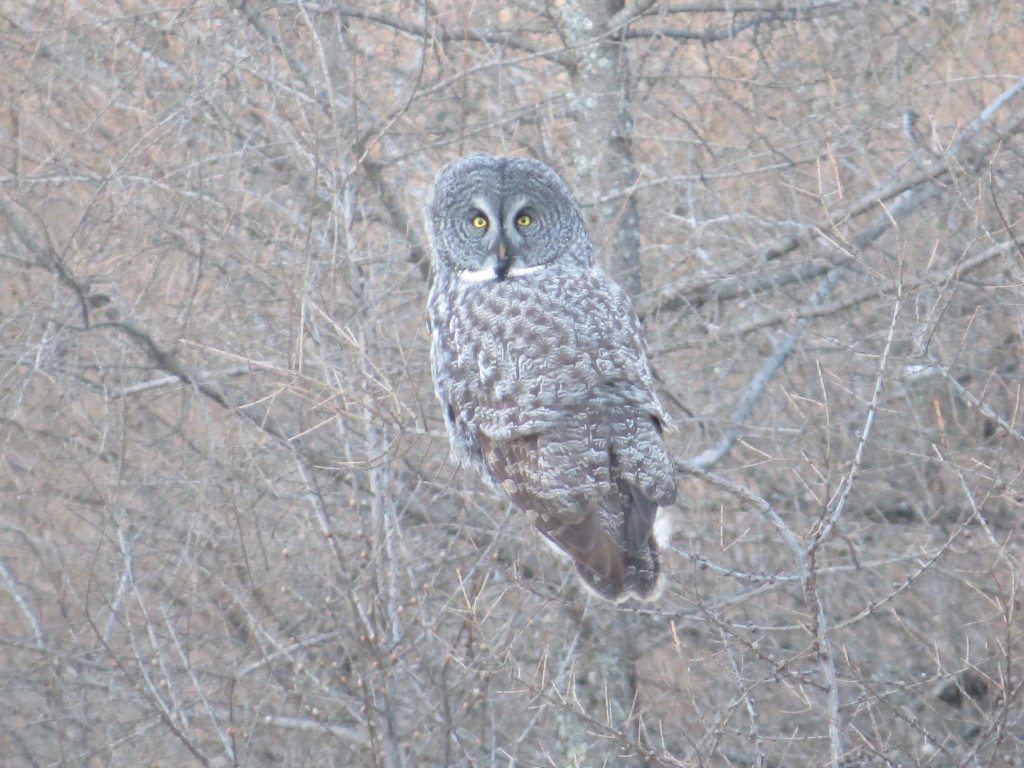
It’s always awesome to see a single Great Gray, but seeing three of them was tops. Five Great Grays in Aitkin, eight Burrowing Owls in Arizona, and now three Great Grays in the Sax-Zim Bog – this family has had some incredible owl-prowls together.
I’d like to leave you with a short clip of this Great Gray. In the future I hope to do more video of this species because they are fascinating to watch.
Minnesota’s Not-So Common Eiders and some Big Bonus Birds
1966. That was the last time a Common Eider had been reported in Minnesota. Now two juveniles show up on Lake Superior in Duluth, and a third one shows up an hour up the shore at Silver Bay. Birders of all stripes were flocking up north and churning out continual updates on the ducks. Yet all week neither Steve nor I hadn’t even brought up the idea of a chase. The White-winged Scoter on Green Lake changed that. Now face-to-face and excitedly bantering about sea-ducks, we decided that we, too, would make a fast trip to Duluth – going up and coming back on the same day. It is a life list after all and neither Steve nor I had another 50 years to wait for another return of the Common Eider. So a week ago last Sunday Steve picked me up from church and we made the 3.5 hour haul up north. A week before this I was returning from Duluth. Crazy.
There was an eerie lack of reports on the Eiders this Sunday, either positive or negative. We brushed it off, but when we got to Duluth and reached the 21st Ave exit, we were nervous that this would be a bust. Steve nervously tapped the steering wheel as he looked for a place to park. In a matter of minutes we parked, piled on the cold-weather gear and optics, and walked to the shore. The icy, gusting wind was coming straight off the lake and biting any exposed skin and drilling the cold into our bones. What was stinging worse, though, was that we were not seeing the Eiders. Now what? With no throngs of birders looking today, do we keep searching the vast shoreline in Duluth alone or do we go another hour further north to hopefully see the Silver Bay Eider? It was a horrible dilemma and a decision had to be made fast. Finally Steve and I settled on walking the lake walk. With the wind coming in as strong as it was, we were looking for a cove or anything that would provide a calm area for a duck to be. The wind was blowing into our faces the whole time and body parts were going numb. Then, it was like somebody hit a defrost button when Steve said, “Hey, what’s that?” There on the water was a duck bobbing up and down in the surf that crashed against the ice-covered rocks. Too small for an Eider, but the perfect size and coloration of a juvenile Harlequin Duck! Wow, neither of us expected this lifer on this trip.
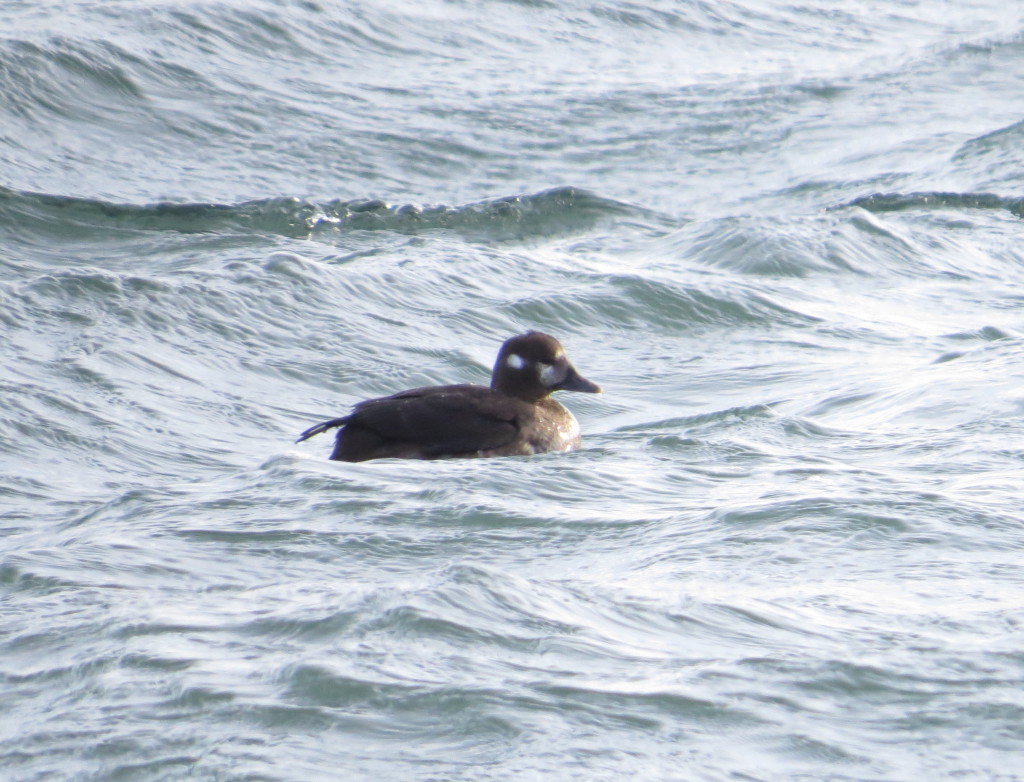
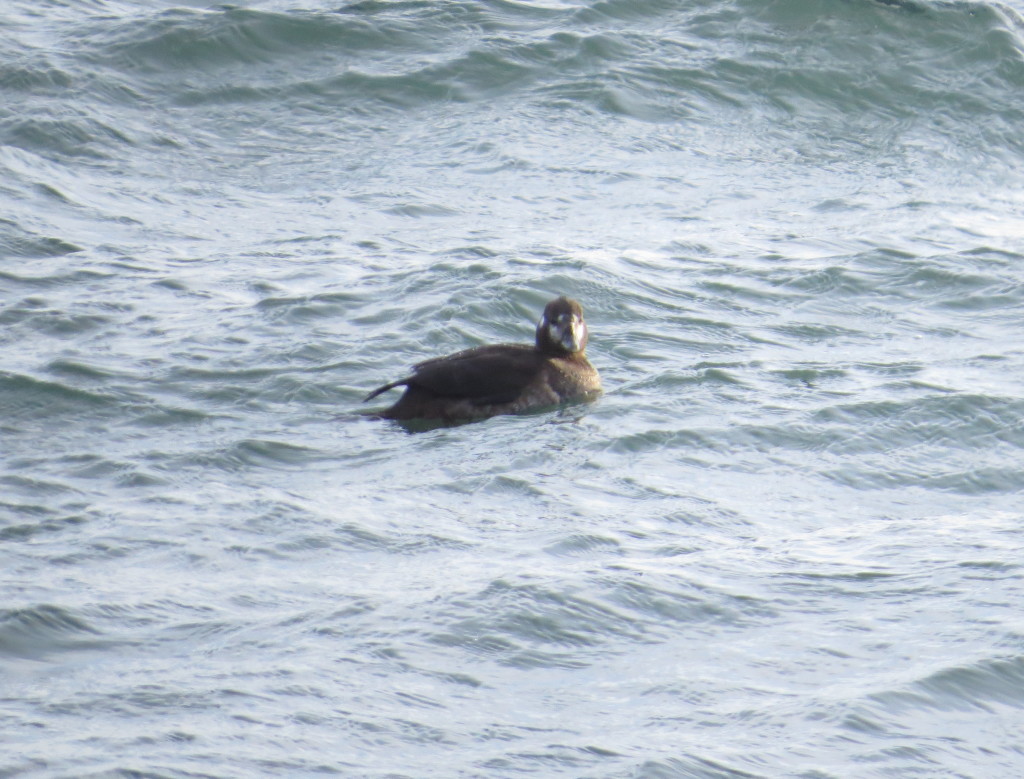
It wasn’t the mature Harlequin drake I hope to see someday on the North Shore, but this was a tough-to-get addition for the life list. The Harlequin was hanging out almost right next to the ice-covered rock on the point below.

Satisfied with one heck of a consolation prize – if it came to that – we continued walking down the lake walk. As we got to a larger cove across from the Essentia Health building, I spotted the biggest duck I’ve ever seen in my life. I didn’t even need binoculars to know that we had found what we came for – the Common Eider. I looked for the second Eider that had been accompanying this one, but all I could see was this loner. It was absolutely huge. According to Sibley, it is the largest duck in North America
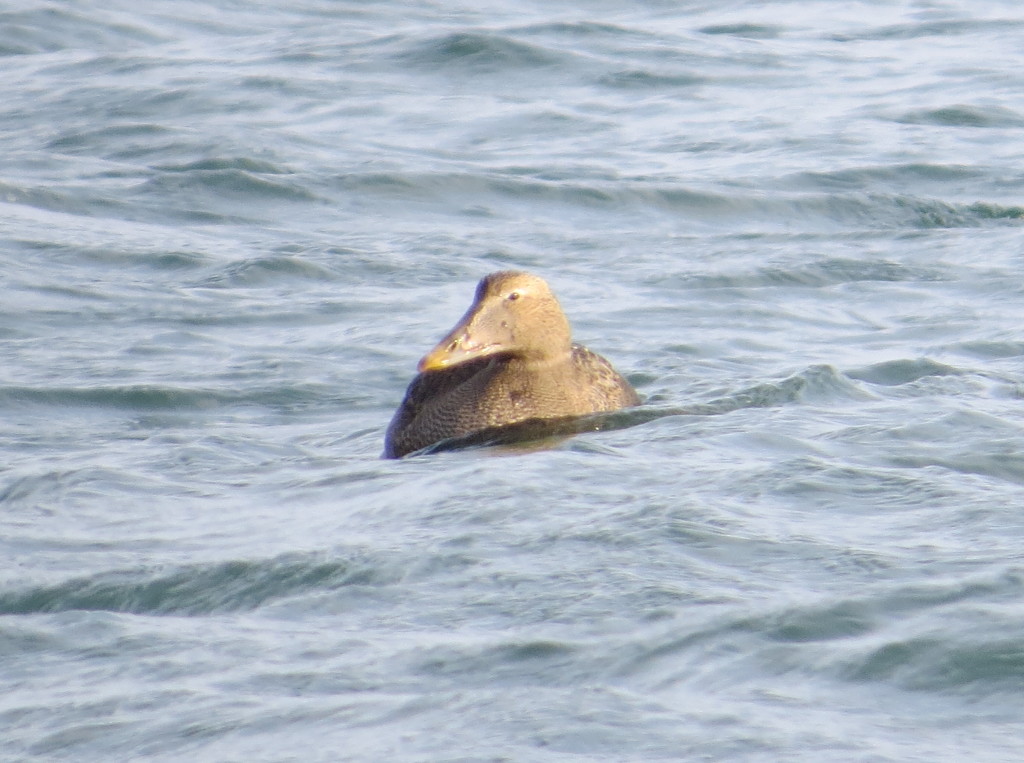 Again, not a mature drake, but when a duck waits nearly 50 years to make an appearance, you try not to complain. And actually, it is so intriguing that some fools risk hypothermia and broken bones trying to get better looks.
Again, not a mature drake, but when a duck waits nearly 50 years to make an appearance, you try not to complain. And actually, it is so intriguing that some fools risk hypothermia and broken bones trying to get better looks.

It was worth it.
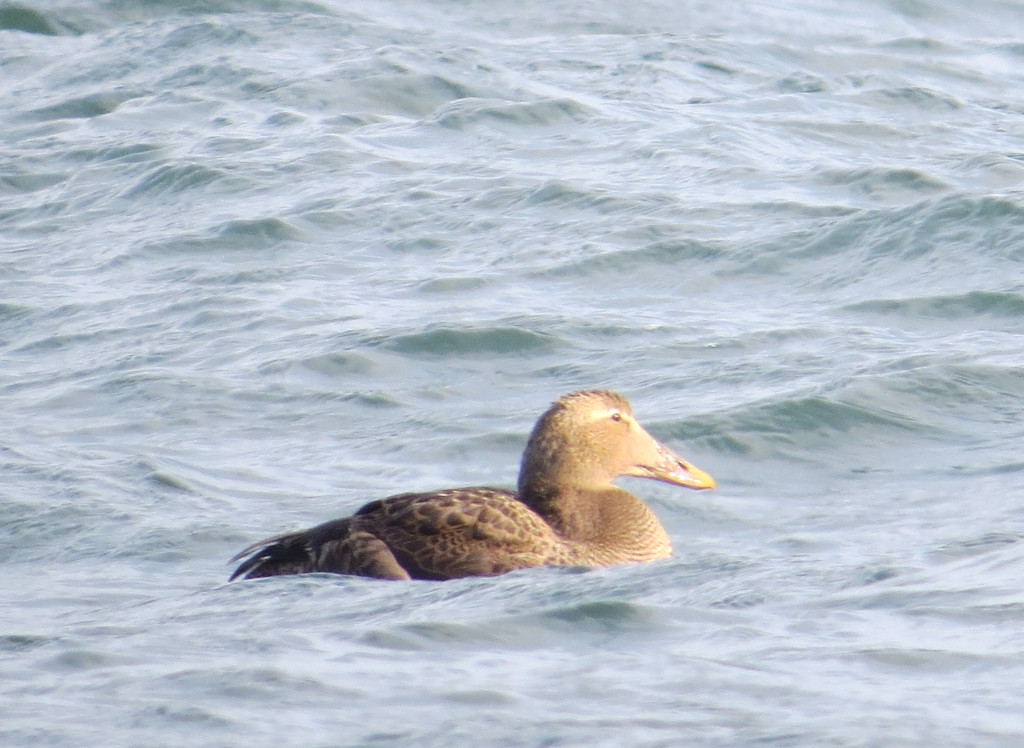
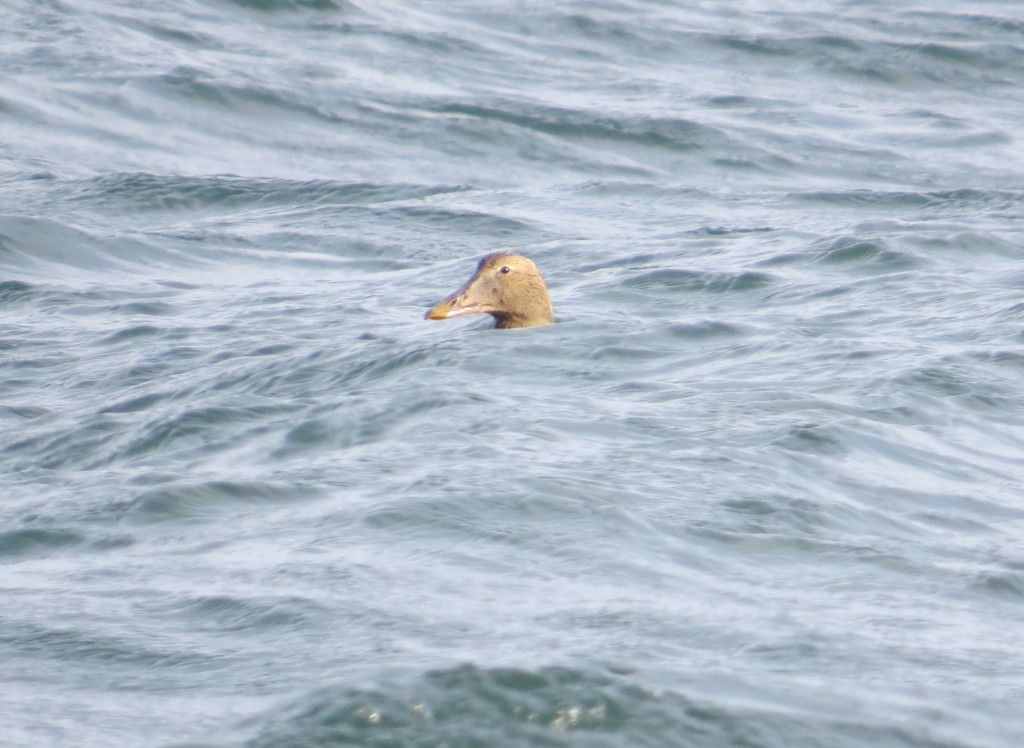
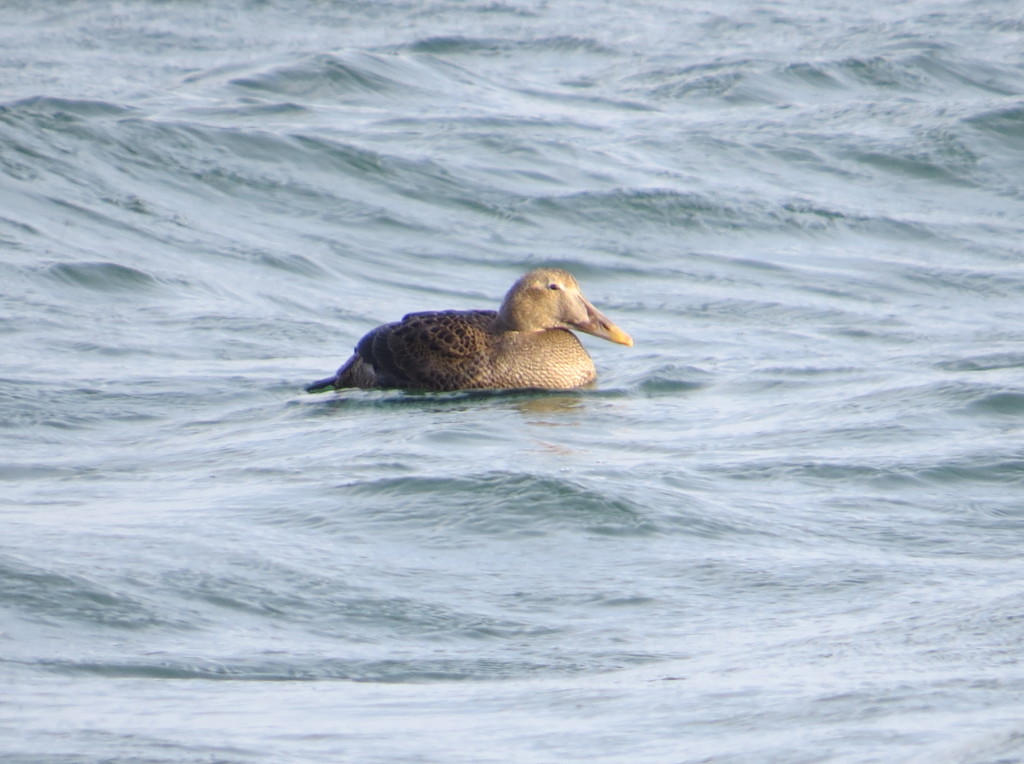
We were ecstatic – we got what we came for and had seen our third sea duck in two days. Literally and figuratively, the wind and sun were now at our backs as we walked back to the car. We again got to enjoy the Harlequin as it motored with the waves further up shore. Can you find it?

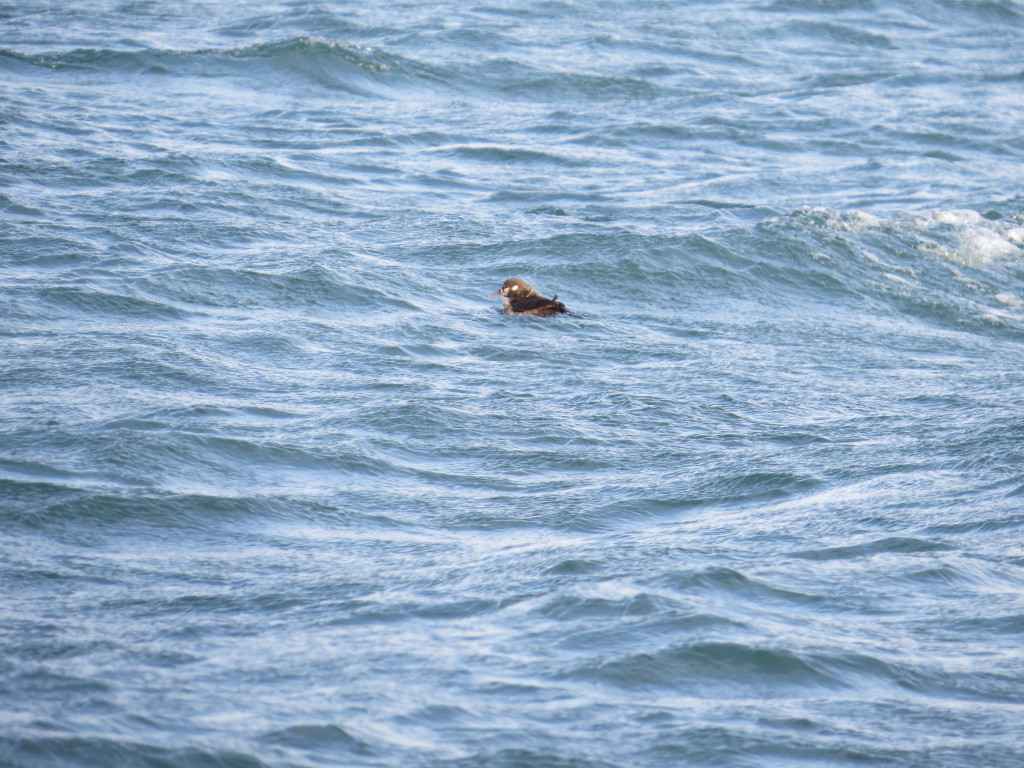
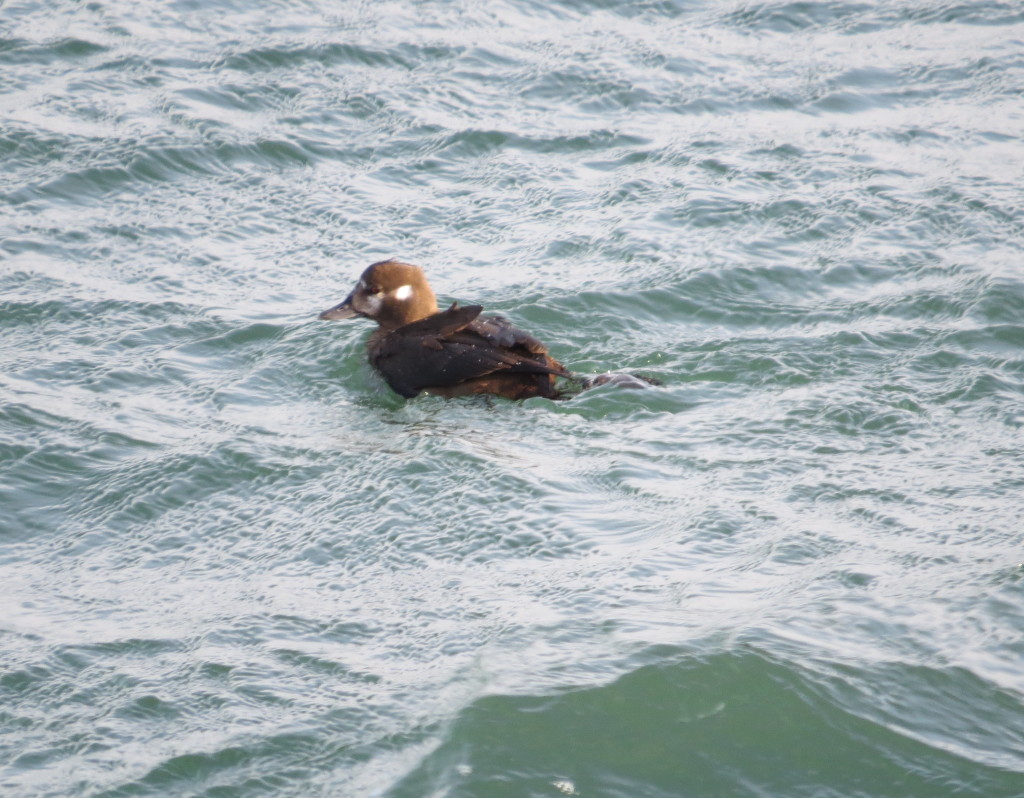
As if we hadn’t had enough excitement for the day, we got to the car and read an email from the listserv that a flock of Bohemian Waxwings had just been found in Floodwood, which was a half-hour away. Steve had an interest in looking for Bohemians up in Beaver Bay, but we decided that was too far up shore. Floodwood, though, was not too far out of the way on our way home. So we went to Floodwood, and we found the Bohemian flock. Steve got his third lifer of the day, and I finally got to get more than just a fly-by look at this bird. It would have been nice if they came closer to the ground for some better photos, but these will have to do for now.
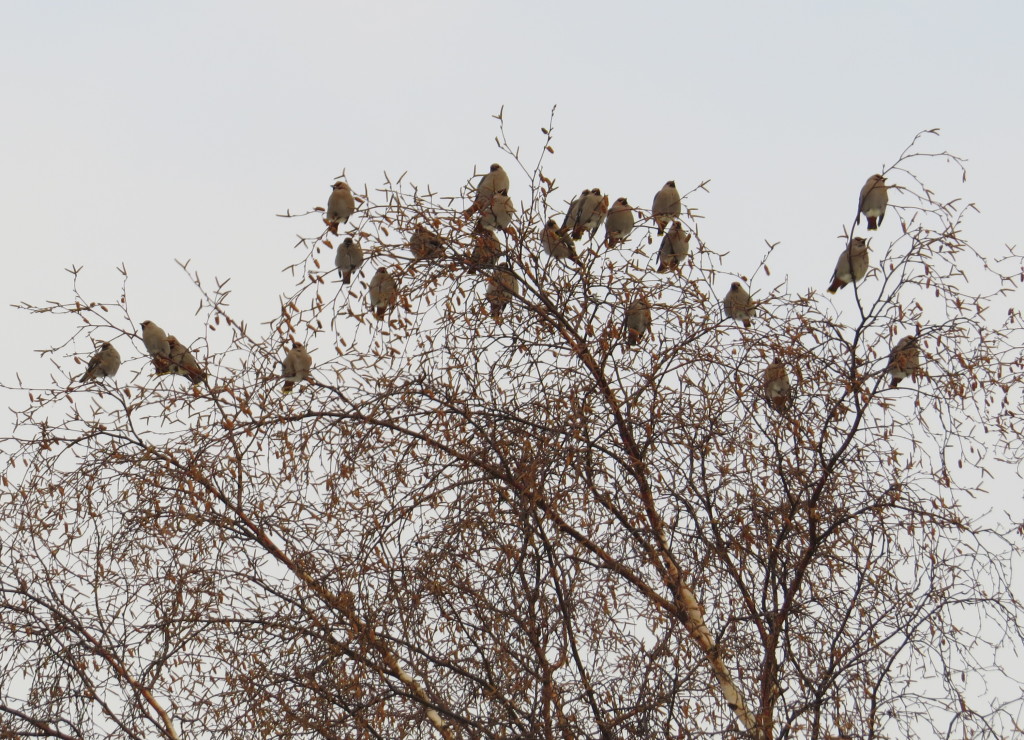
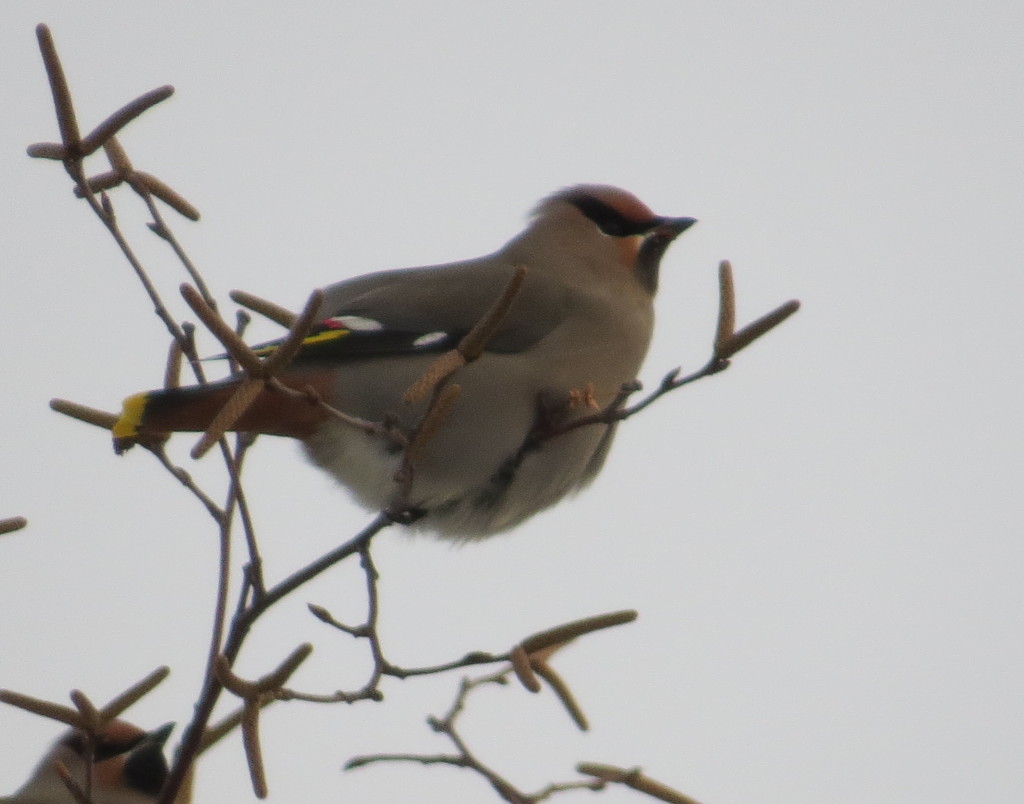
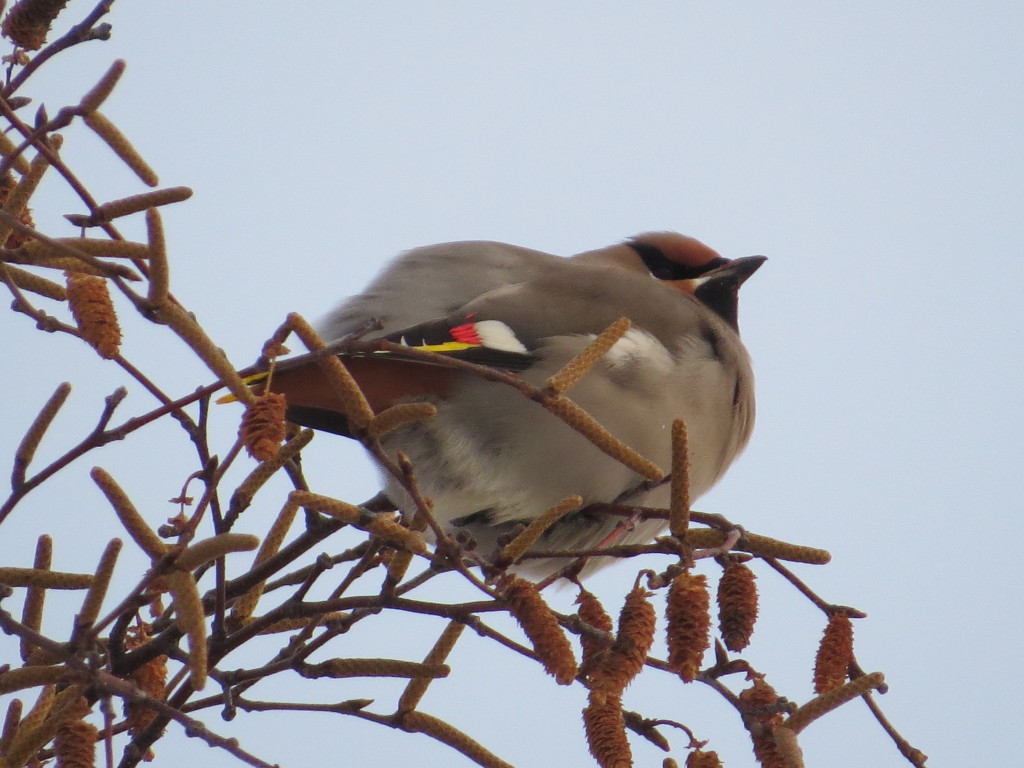
It was finally time to head home. We had a couple other nice northern Minnesota bird sightings including Common Raven and Ruffed Grouse. We were hopeful that we would bump into an owl or two as we cruised south through the boglands along Highway 73 just before dark. We never did see an owl, but it didn’t matter because we were on our way home from a monumental day of birding.
A Scoter Kind of Day
All of last week I had been reading reports of a stunning find for Minnesota – three Common Eiders had shown up on Lake Superior, the first time since 1966. So last Friday night when Melissa came home from chaperoning a dance I told her I was thinking about getting up in a few hours to head back to Duluth after going there just a week ago. I agreed with her response that I was crazy. So I dashed my Eider dreams and settled for a Snowy Owl search, a more local, reasonable way to get in a good birding fix on a Saturday morning.
So it was an owling I went on this snowy morning. I was finding fun birds like my first-of-fall flock of 100+ Lapland Longspurs and Snow Buntings, a group of 8 Wild Turkeys (all jakes and toms), and over a dozen of these guys which I haven’t been seeing much of all year.
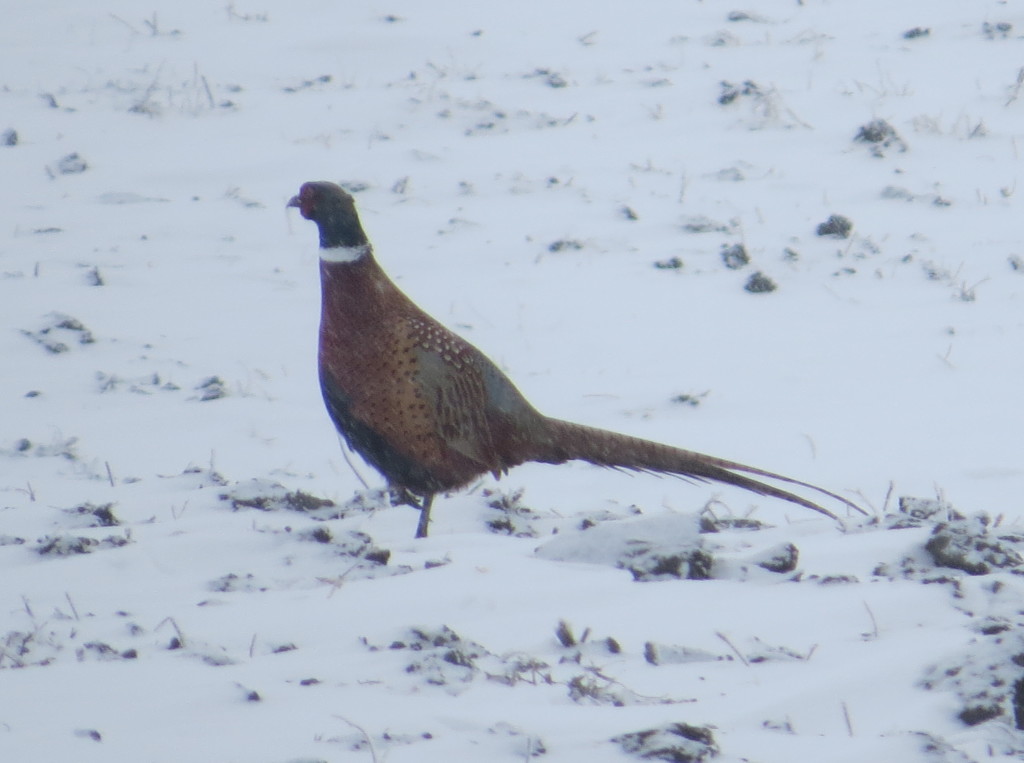
I wasn’t seeing what I was seeking. It was disappointing because I thought my chances were good. As my Snowy Owl route eventually brought me closer to Spicer, I thought about heading into Willmar to try for some better Varied Thrush photos or even to check up on a older report of a Northern Mockingbird in town. However, as I drove around the very large Green Lake, I noticed that it hadn’t iced over yet unlike the smaller lakes and ponds. Gears shifted completely – suddenly I had the urge to look for Scoters.
I stopped at the public beach at Spicer and walked up to the calm water. There was some debris in the water right by shore that I hadn’t looked at twice. That is, until that debris started moving. I was startled to see this family of Trumpeter Swans. Not an Eider, not a Snowy Owl, but still another fun bird to add to the morning’s outing.
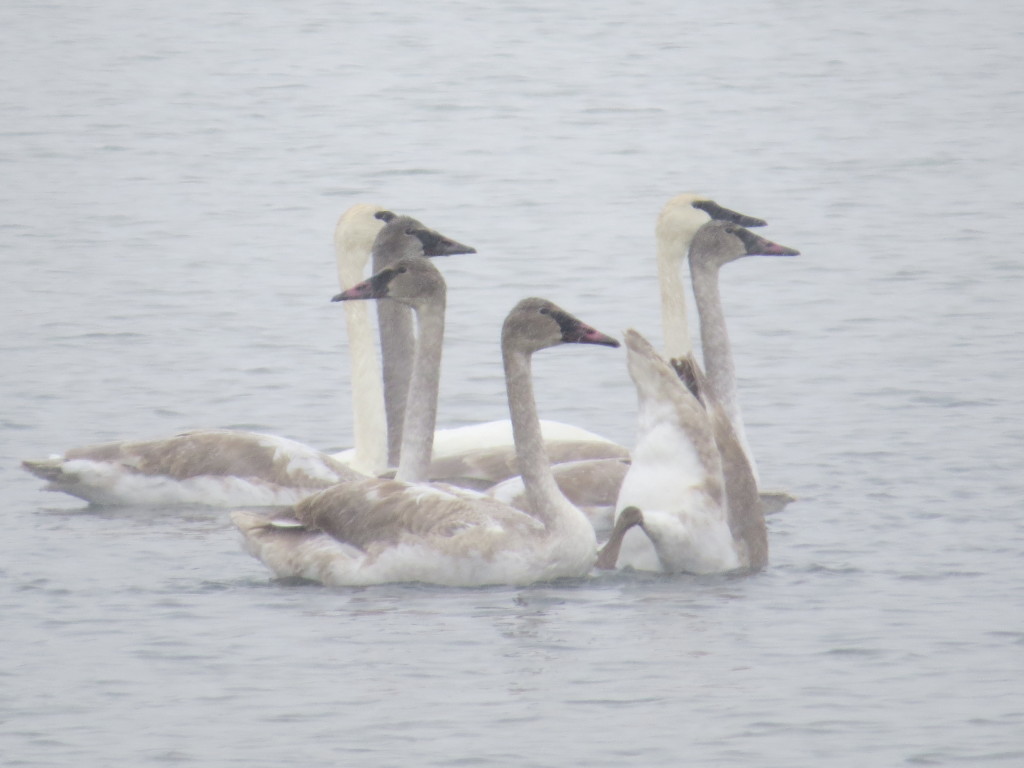
As neat as swans are, I didn’t come here to see them. So I scanned the lake to the east past Zorbaz Restaurant where I saw a large group of waterfowl at a distance. The naked eye showed that most were Canada Geese. The zoom on my camera revealed a couple of ducks I would have liked a better look at, but I just couldn’t make any IDs. Then an interesting bird right near the pylons at Zorbaz caught my eye. It dove and then wouldn’t come up. I was hoping it was a Scoter. After a long wait I never did see it resurface. Finally, I gave up and went to the public boat landing to check out the lake from there. That unknown bird was bugging me, so I decided to go back to see it.
Well, I saw it and was greatly disappointed. Pied-billed Grebe. It doesn’t get more boring than that. I took one last scan to that group of geese and waterfowl to the east. What’s this trucking my way through the blustering snow? I see a very dark duck, low to the water, with a wide bill. It’s V-shaped wake was getting bigger as the duck was cruising toward me. Could it be? It turned its head revealing two big white spots on its head. Holy smokes, it is! A White-winged Scoter!!
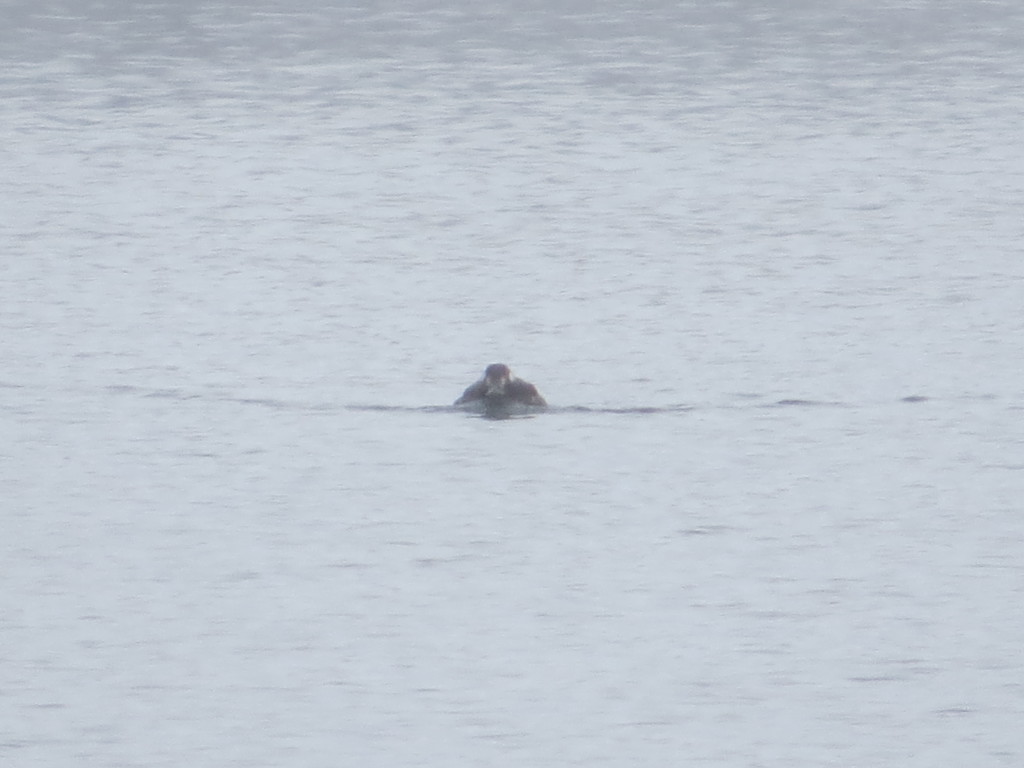 Evan and I just got this lifer exactly one week earlier on Lake Superior where it is not a rare duck. Here, though, in the middle of the state, this was a spectacular find. There previously had only been three instances of this bird in Kandiyohi County. And the cooperative duck just kept coming my way!
Evan and I just got this lifer exactly one week earlier on Lake Superior where it is not a rare duck. Here, though, in the middle of the state, this was a spectacular find. There previously had only been three instances of this bird in Kandiyohi County. And the cooperative duck just kept coming my way!
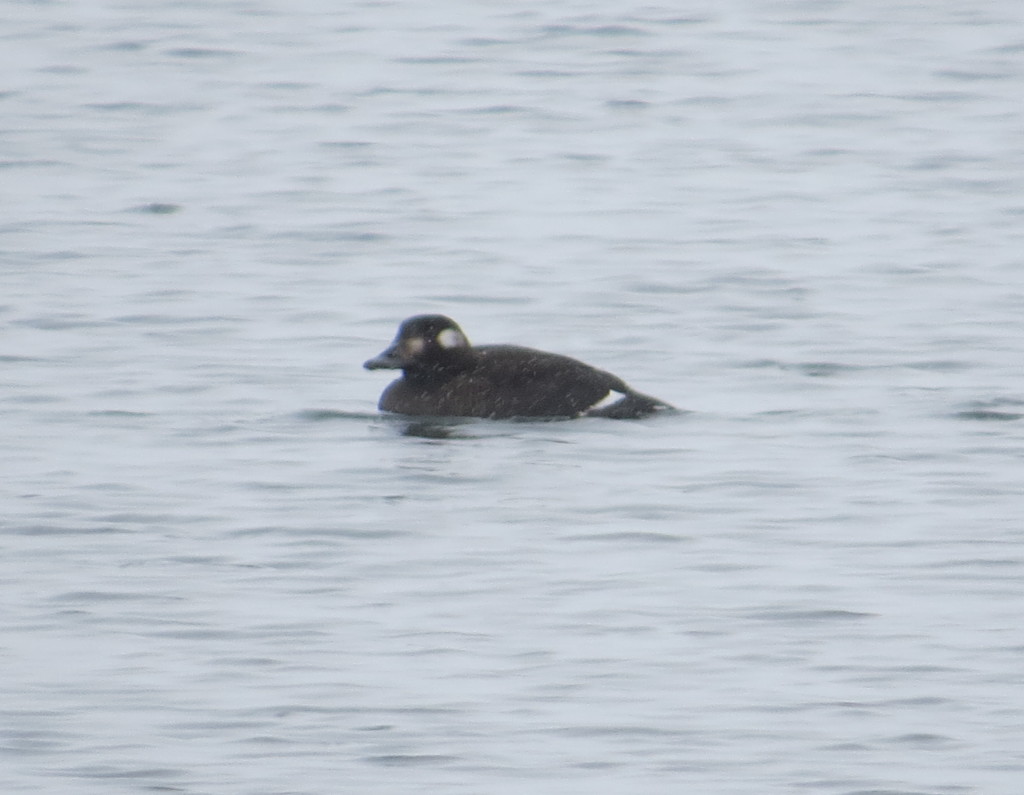
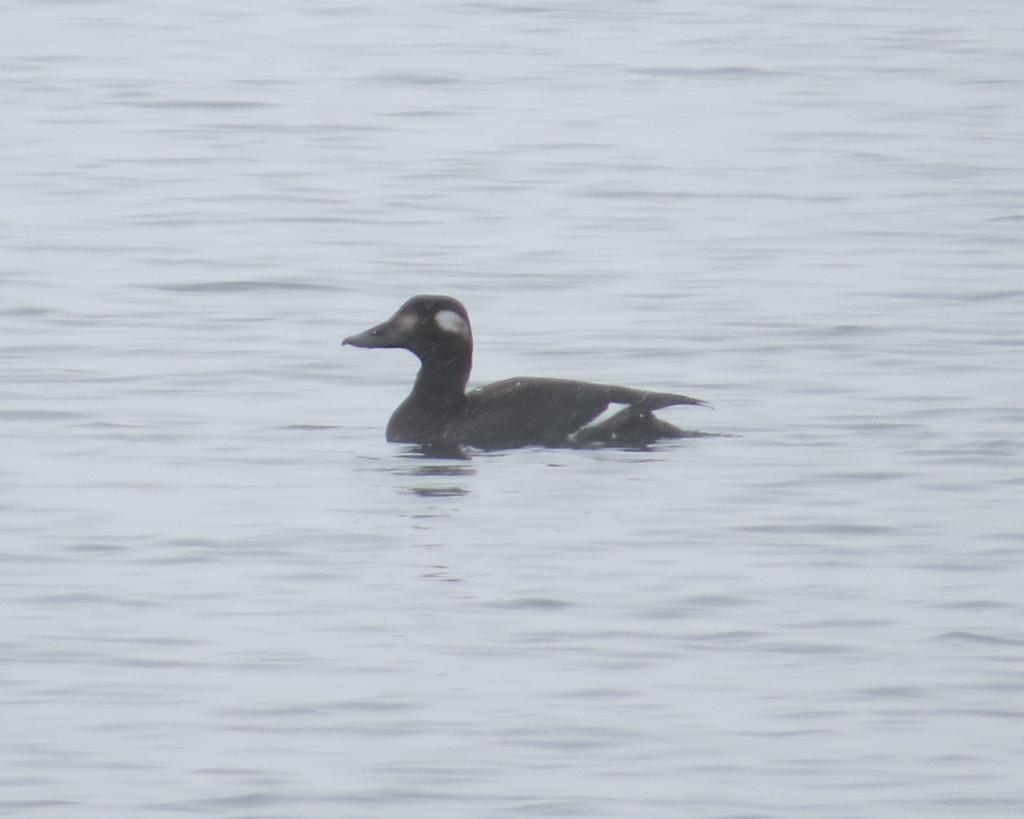
I immediately called Steve, who was just hanging out at home. He scrambled to get to Spicer. I kept an eye on the duck until he and his son, Riley, got there.
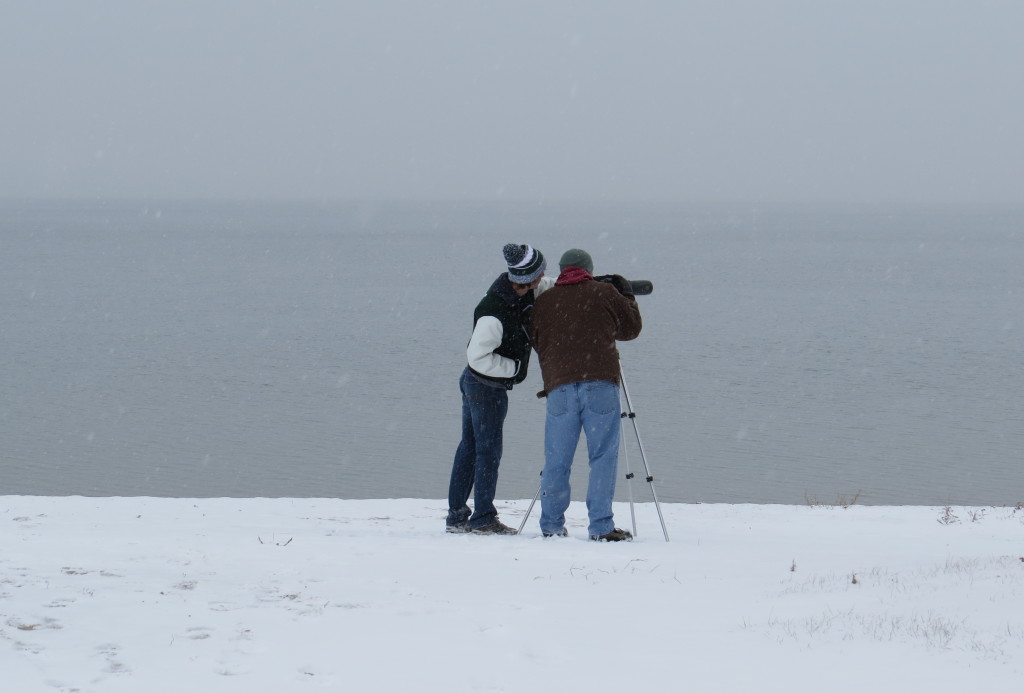
Steve and I were elated – a Varied Thrush and a White-winged Scoter in the county in the same week. It was a dream. What was I looking for again? Snowy-something-or-others?
Amazingly this White-winged Scoter has hung on and is still present at the writing of this post. Many county-listers came out to see the duck after my posting to the listserv. More importantly, though, several birders finally added this duck to their life lists. Helping others get a lifer like this is one of the things I enjoy most about a good find.
I have been out to Green Lake several times since my initial discovery. Only one of those times, though, was to check on this duck. No, there was another big draw that kept bringing me back – more on that later. Anyhow, each time I’m at the beach in Spicer, I see my duck and can’t help but take a photo or two or five. Some days were cold and windy.
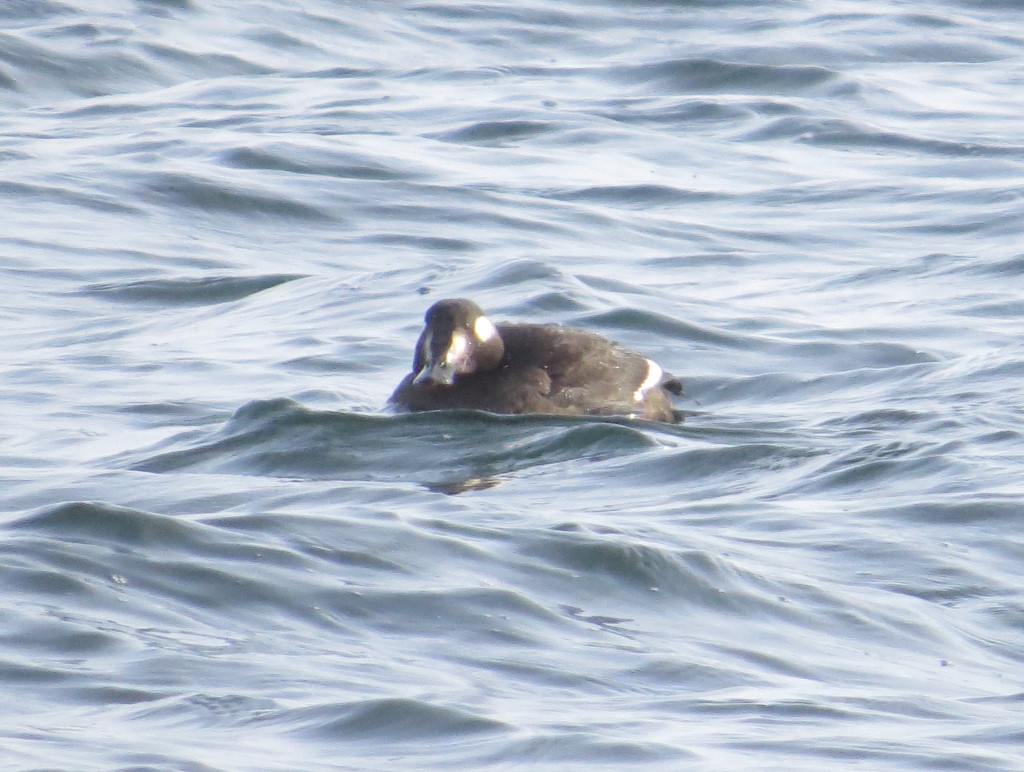
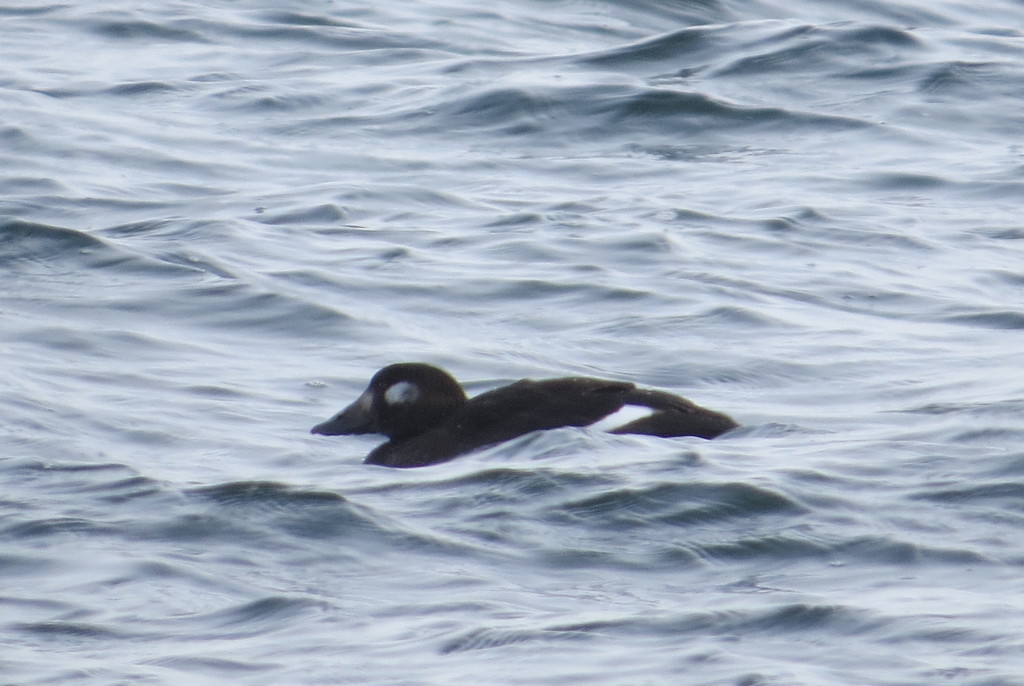
Other days were colder and placid. Much of Green Lake was covered in ice in these next shots, and I suspect that the open water and the Scoter will be gone in the next day or two.
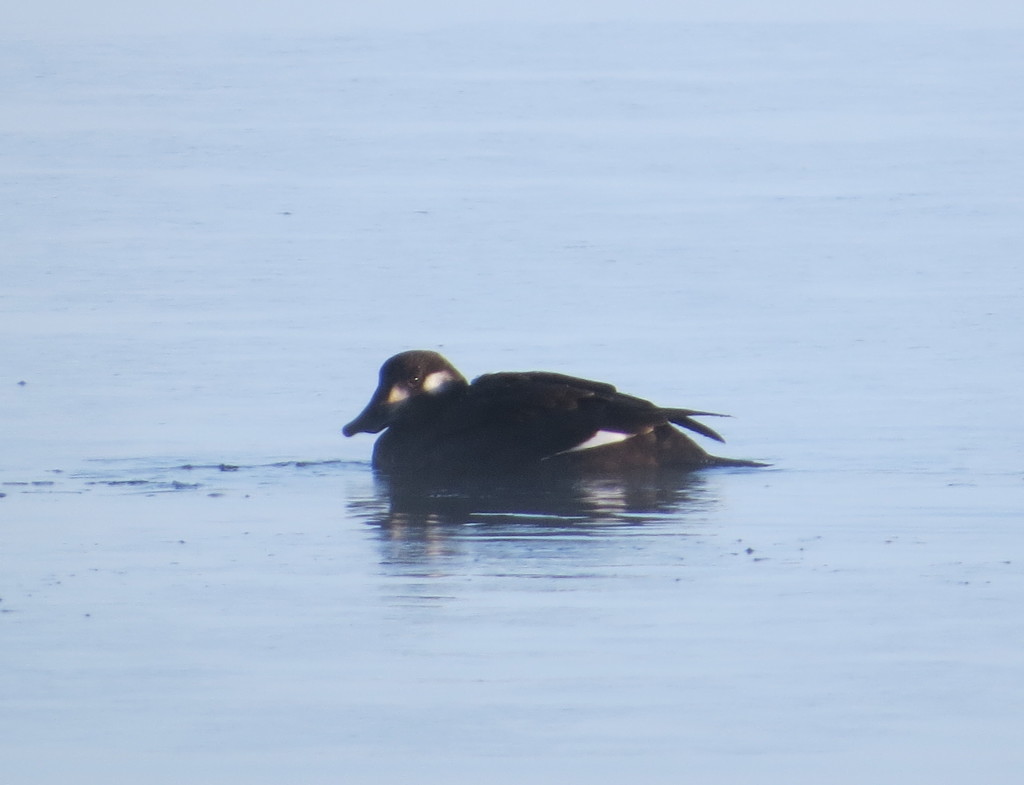
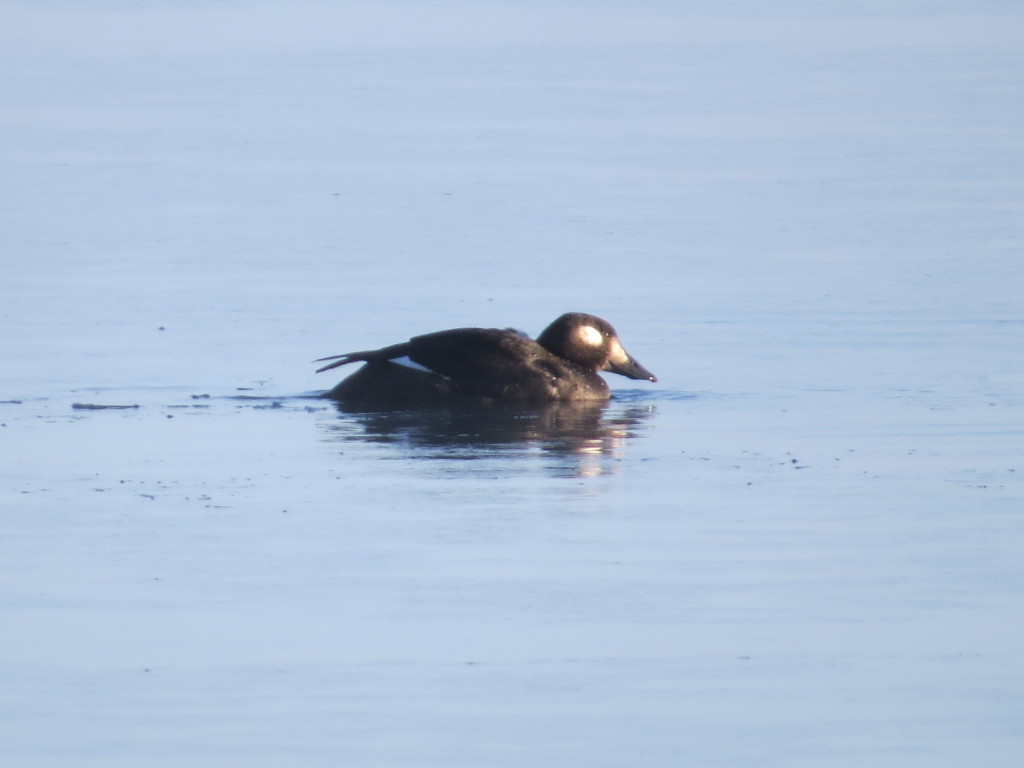
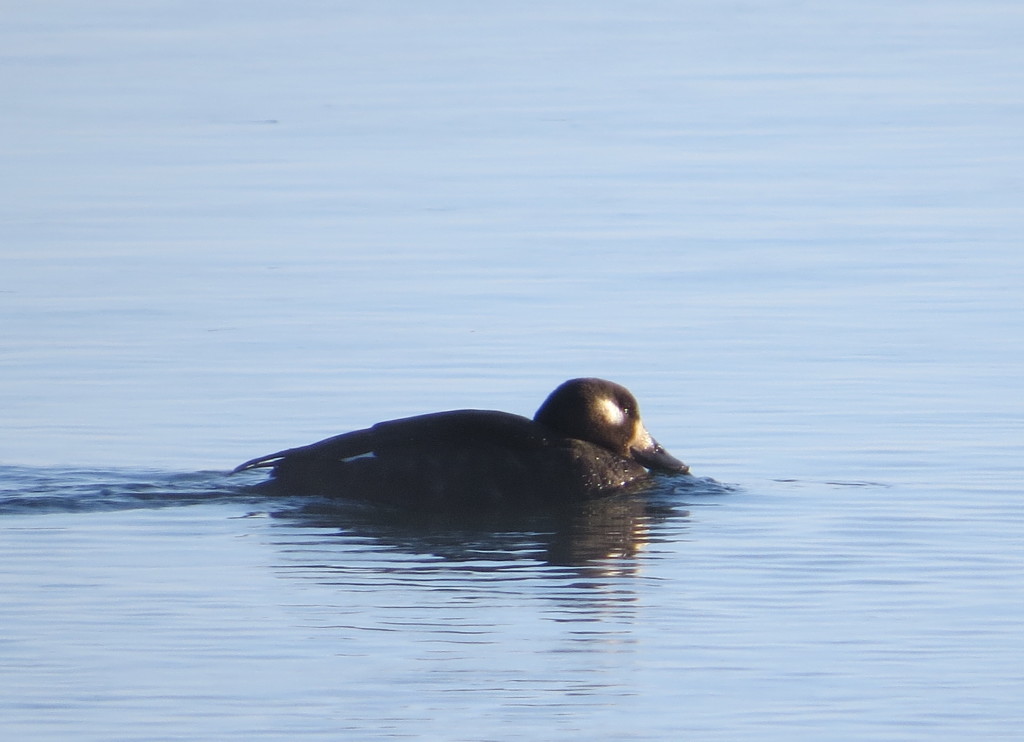
Even though I’ve had more than my share of good finds, this is one of my all-time favorite discoveries. The rarity of it, the fact that I set out to find a Scoter and succeeded, and that so many people got to enjoy it makes this a very memorable find. And it came in a crazy week of birding. Indeed, there was another rare bird that kept drawing me back here. But even beyond that, Steve and I managed to add TWO more sea duck lifers after we saw this Scoter! More on all that later.
November Birds
Last Monday’s blizzard didn’t get its fill of bullying as it stayed on into Tuesday. School was canceled for the second day in a row. While kids rejoice with such news, we adults face the reality of the miserable work of digging out from the storm. One upside is that a blizzard brings on a frenzy of birding activity in the yard. Natural food sources get covered up, and many birds head to the easy pickings of a feeder. The activity was so hot that all of us found ourselves looking out the window at one point or another to see the feathered fray outside. Here are the highlights:
A FOF (first-of-fall) American Tree Sparrow showed up. It is such a good-looking sparrow and a great bird to have in the yard.
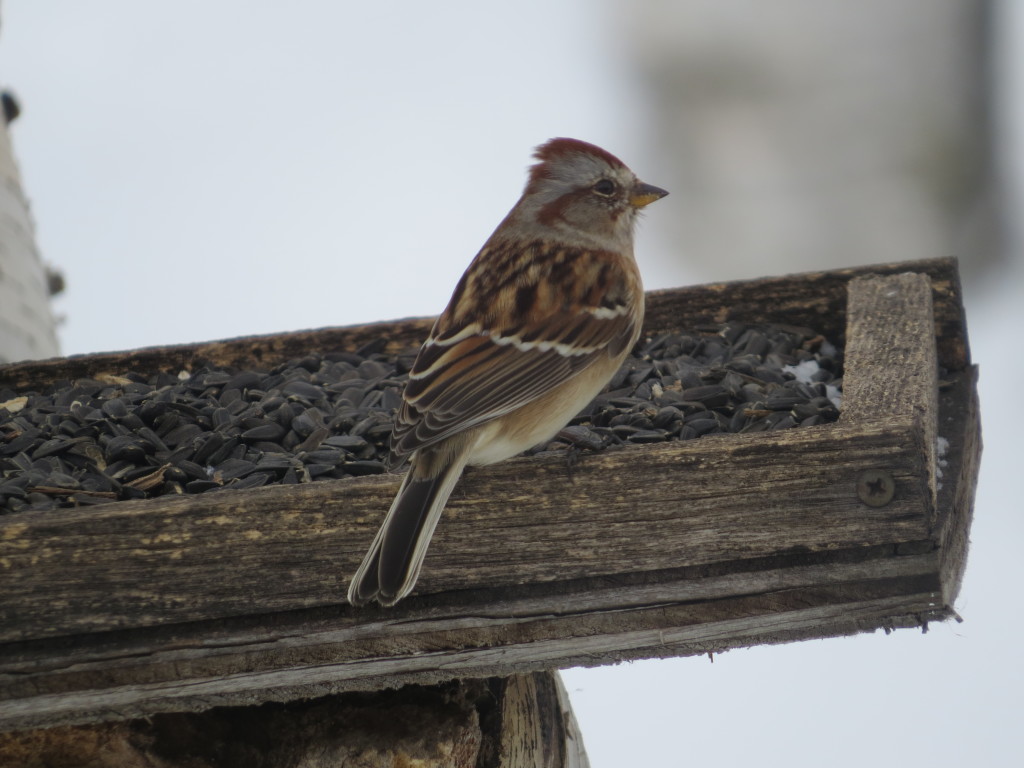
Blue Jays continued to delight even if they were having bad hair days.
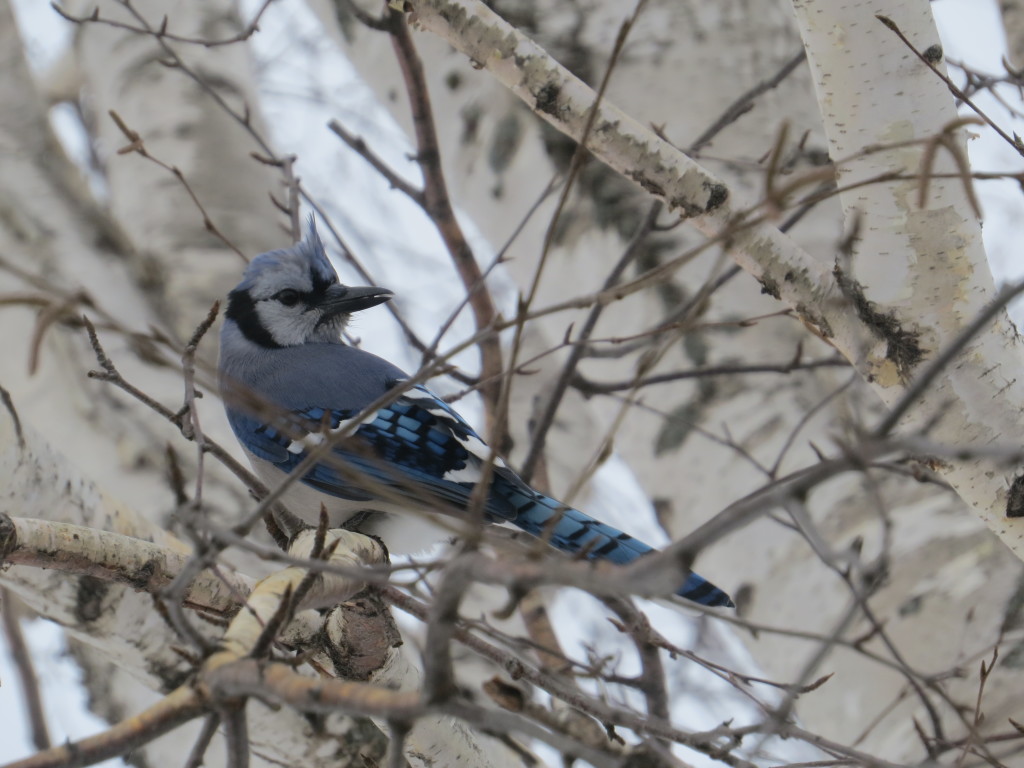
Previously a shy bird for the October Birds post, the Hairy Woodpecker decided to show up along with a couple others! We had a record-high count of three in the yard.
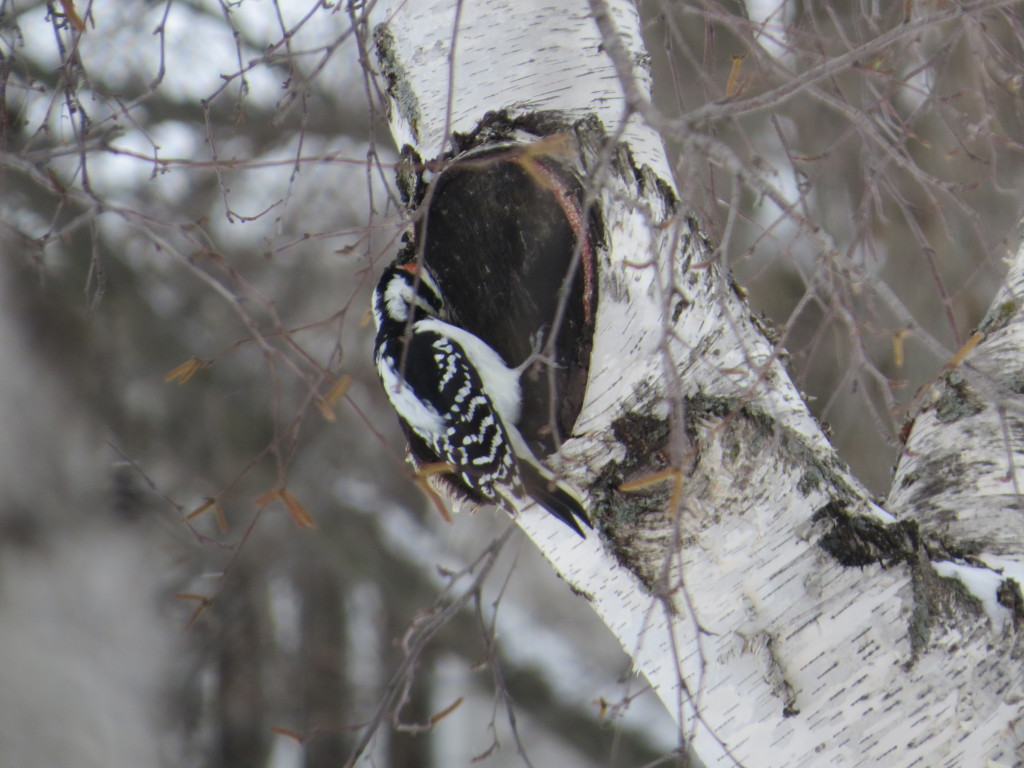
This next bird has long been a family favorite, and on this day our normal pair of Eurasian Collared-Doves doubled! It was another record-high count for the yard. ECDOs are quite uncommon and seldom seen in most of Minnesota, so we are quite fortunate to have them in our yard.
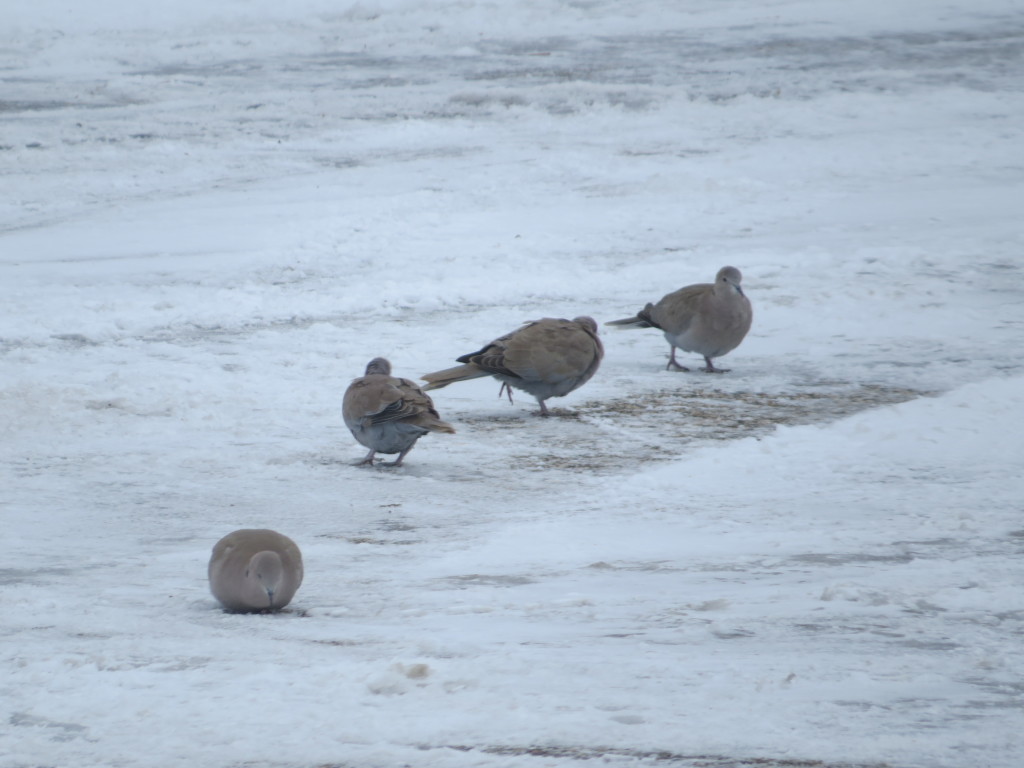
This next bird isn’t exactly a highlight nor very rare, but it is rare to see a European Starling in the yard. Normally I don’t photograph this bird, but it showed up during the photo shoot, so what the heck. And actually, it’s kind of cool-looking.
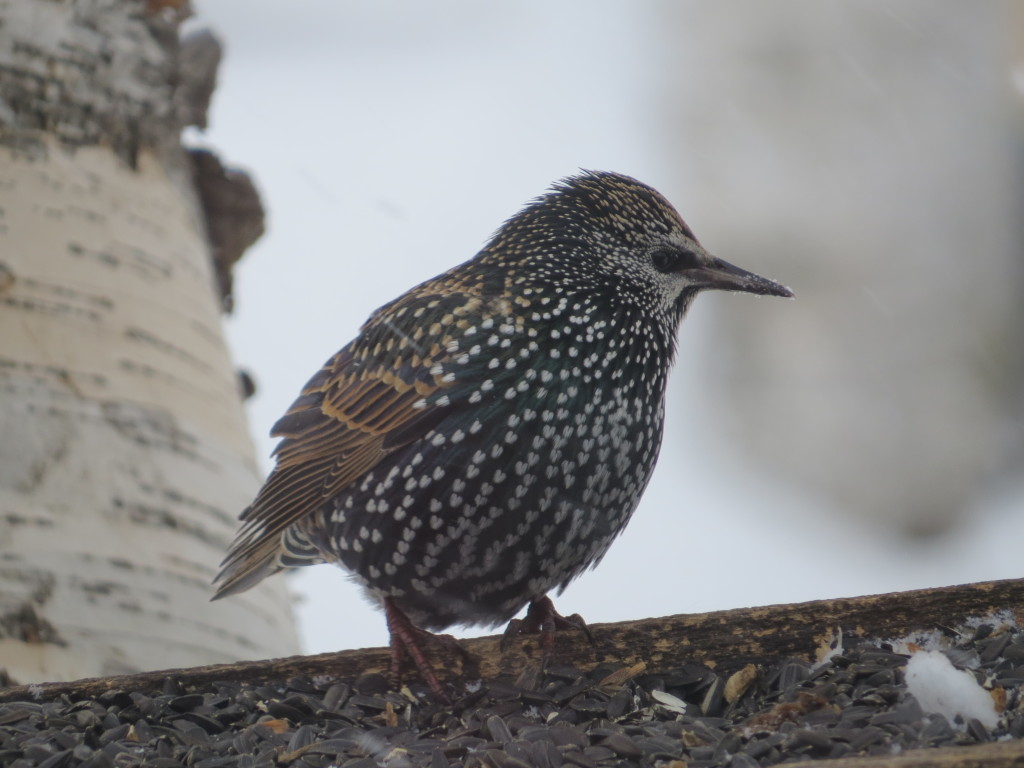
Another bird that missed last month’s photo shoot and that never gets old to see is the Northern Cardinal.
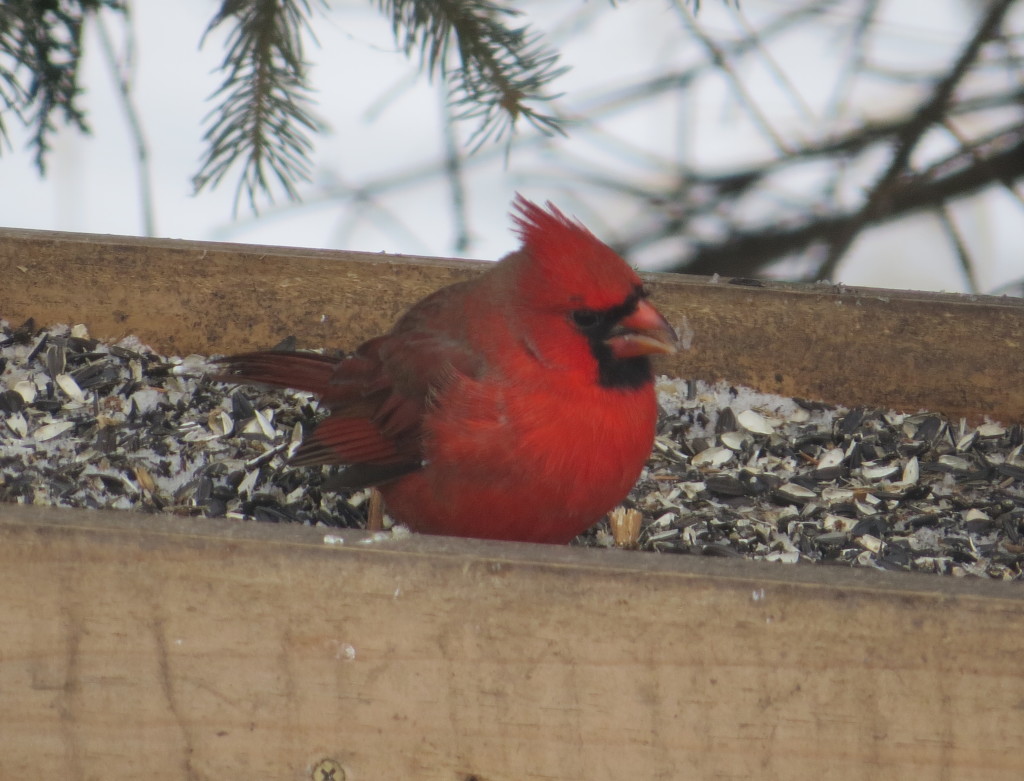
The male, though, was just not very photogenic, always sitting in seed trash or posing with food in its beak. Typically overshadowed by her mate, the female stole the show on this day proudly displaying her beauty with subtle hints of red.
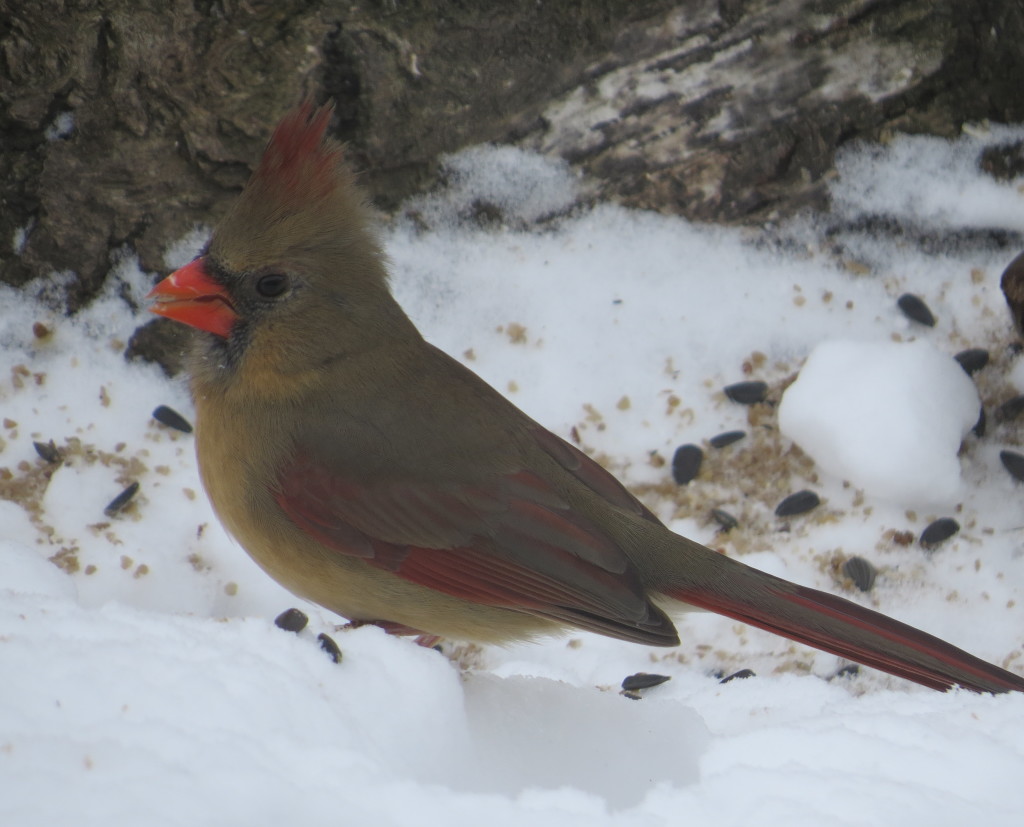
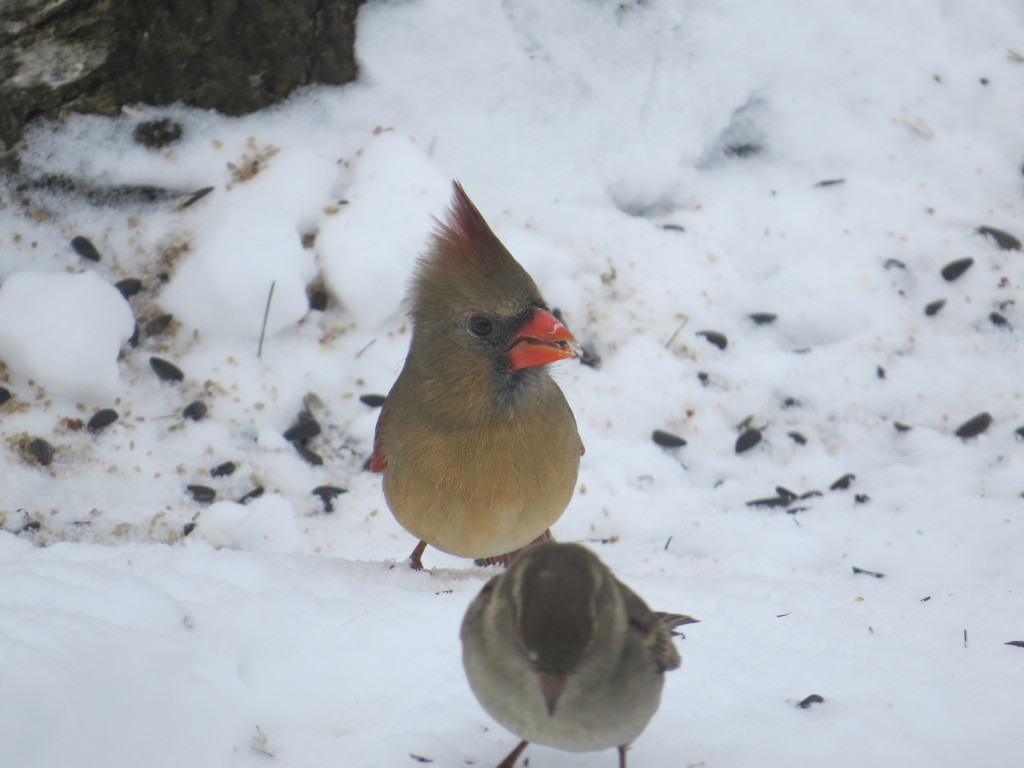
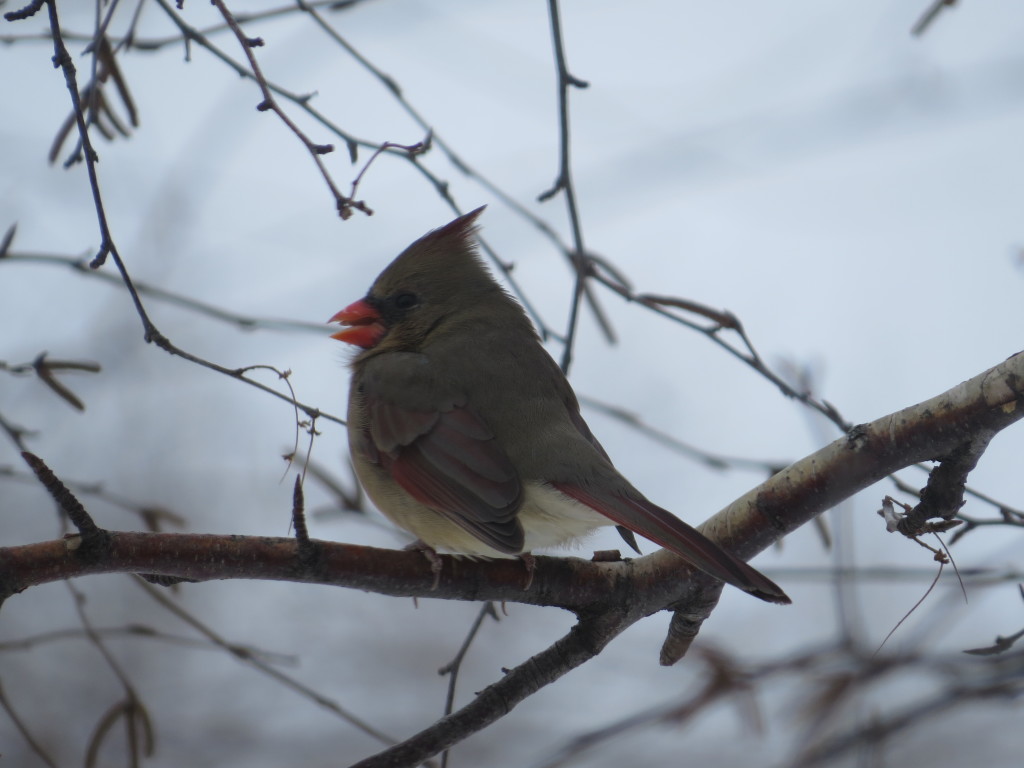 Clearly this female has had enough of being sidelined by photographers and male Cardinals alike.
Clearly this female has had enough of being sidelined by photographers and male Cardinals alike.
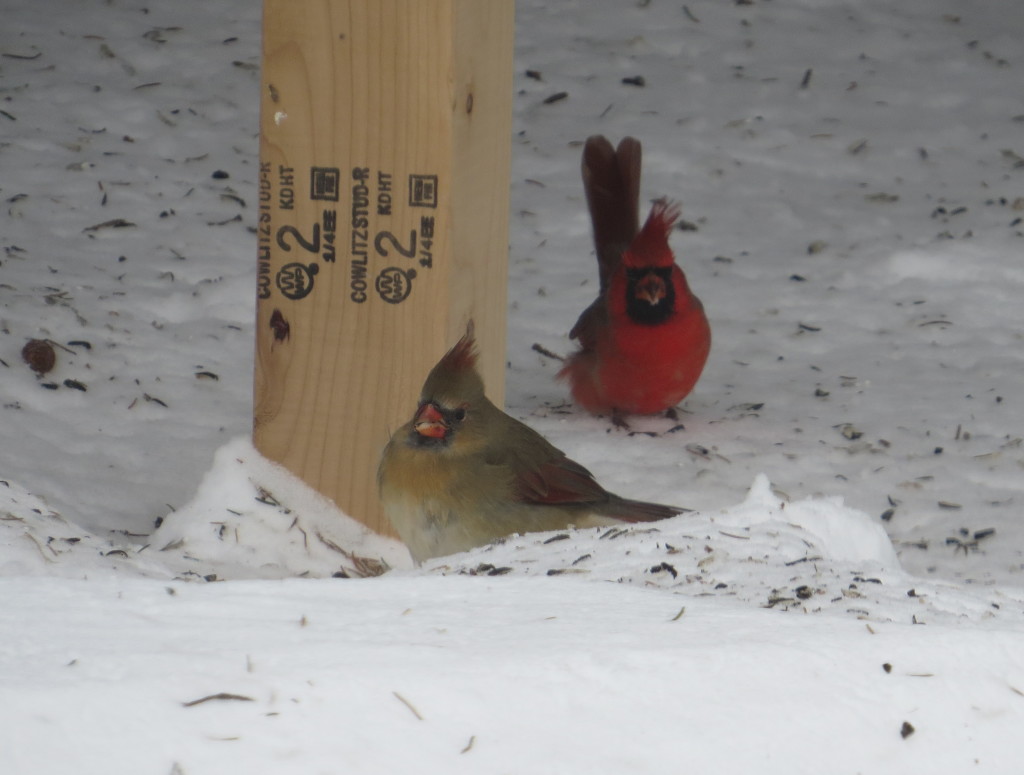
What could be better than a pair of Northern Cardinals in the yard? How about TWO pair! This was another record high-count brought on by the storm. Woohoo!
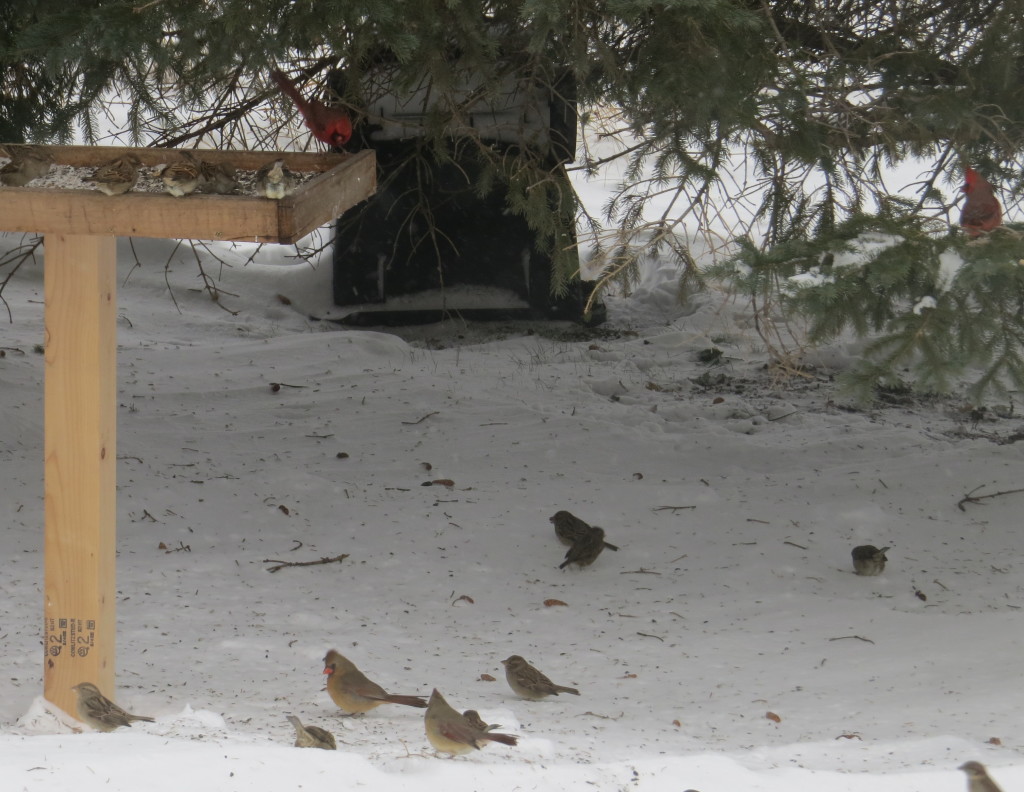
The males did NOT share feeder space.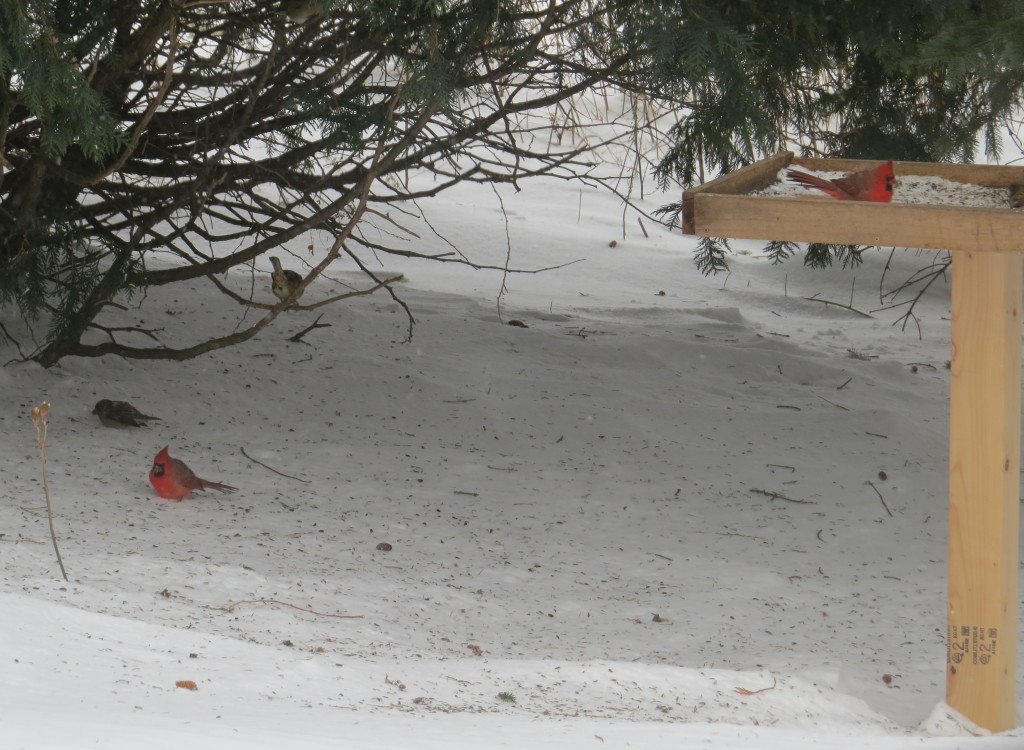
Not pictured in any of my posts are the hordes of House Sparrows that we feed. I would guess over 50. I actually don’t mind them because I consider them bait for something bigger, better. I was in my bedroom folding laundry and not paying attention to the incessant noise of all the sparrows and other birds at the feeders when I heard a huge WOOOOSH as all these birds flushed simultaneously and a loud, collective “CHEEP!” which I’m pretty sure is bird-speak for “Oh S#$%!” I knew a predator had finally come in to nab a meal. I raced to the window, thinking I’d see my Northern Shrike return. To my amazement, a huge raptor swooped in and landed in front of our living room window. It was a Cooper’s Hawk! I hollered for Evan to come see it, but he was in the basement and didn’t hear me. I got out to the living room and saw this guy perched just 6 feet from the window.
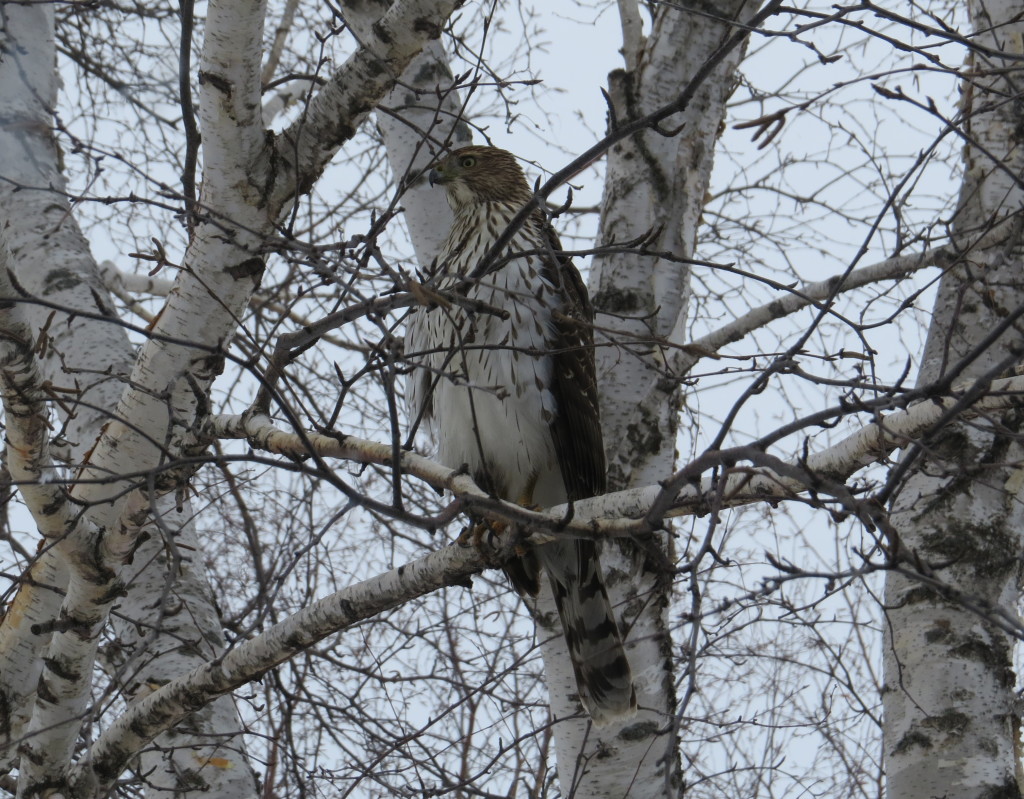
I left this next photo uncropped so you could see just how close it was – you can see the soffit of my house in the upper right of the photo.
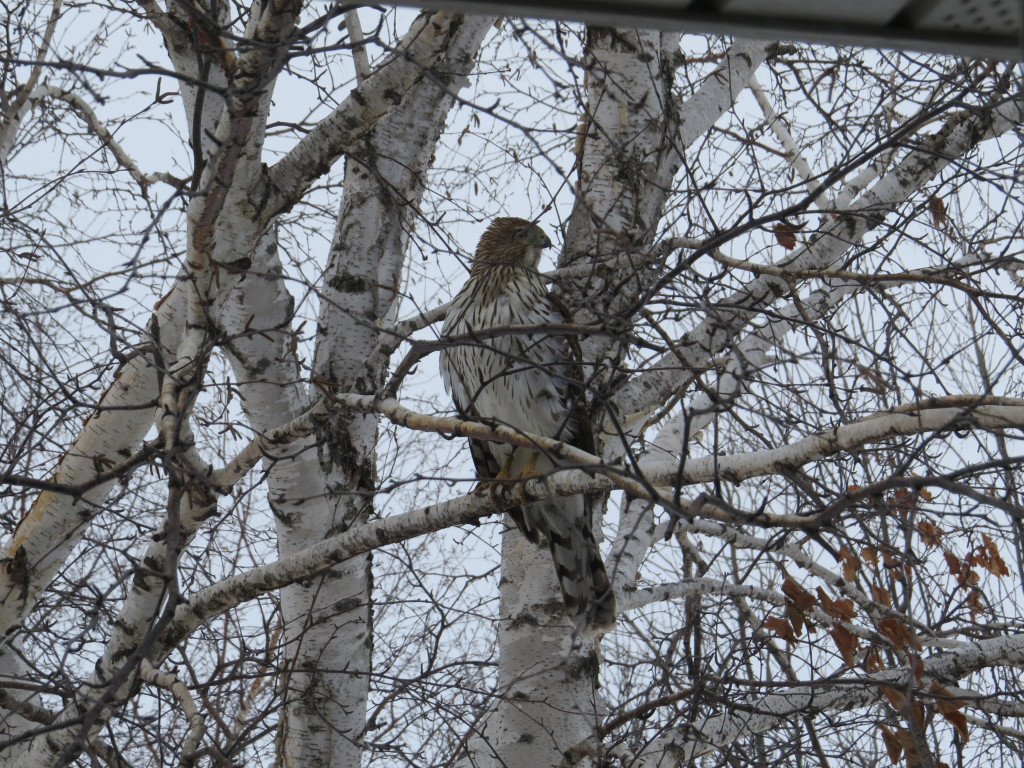
This was a cool sighting. Too bad it didn’t grab a sparrow or two before it tried to fly into my living room and then leave.
Another highlight bird that showed up a week after this stormy day was a Fox Sparrow who was very late but still very much the life of the yard party.
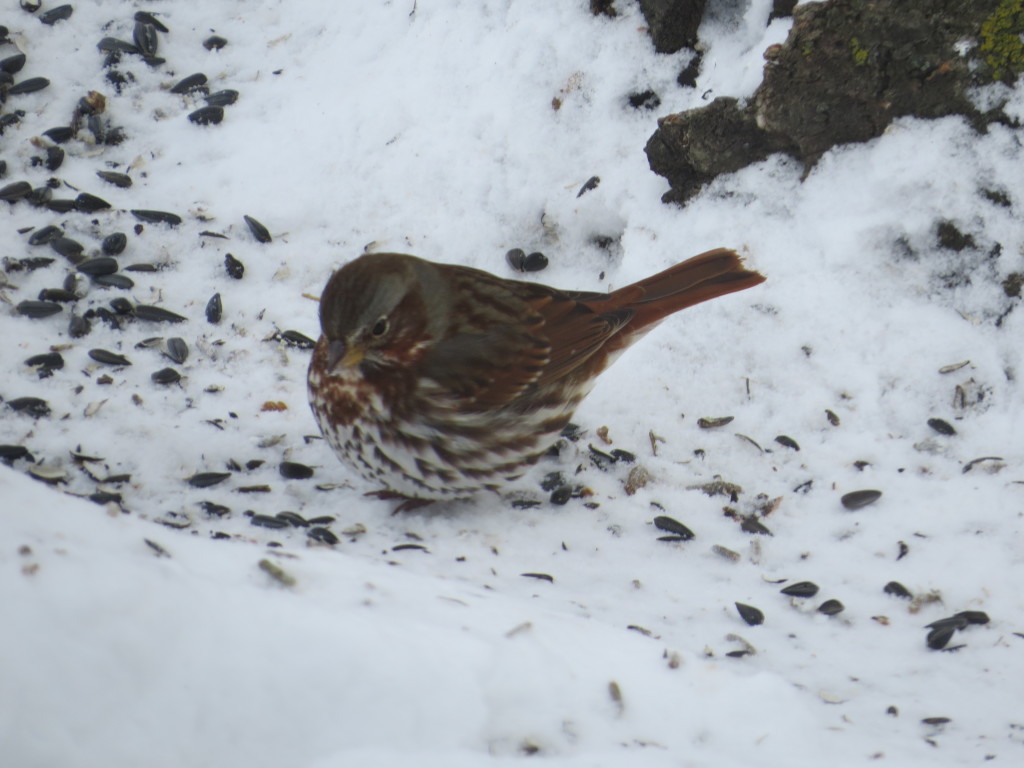
Storms are fun if you’re a birder. It turns out that the day that brought us the Varied Thrush also delivered a duck gift to Minnesota on Lake Superior. This news would start a week-long internal storm of sorts for this birder.
